

Ultimate Guide to Hiking the Simien Mountains of Ethiopia
The Simien Mountains National Park, a UNESCO World Heritage Site, is a rugged and remote chain of mountains that stretches across northern Ethiopia.
The tallest peak in the Simien Mountains is Ras Deshen reaching above 4,500 meters and the second highest peak is Kidis Yared reaching a close 4,453 meters. These tall peaks make for a dramatic and breathtaking backdrop no matter how long you choose to hike in the park.
With its jaw-dropping views of wild landscapes and wildflowers to its rare wildlife containing Gelada Baboons, Wallia Ibex, and Ethiopian Wolves, the Simien Mountains is a rarely visited wonderland of nature.
All of those attributes combined are what make this place one of the best hiking destinations in the world and rightfully so has earned hiking in the Simien Mountains a spot on our Top 100 Travel Adventures list.
Hiking in the Simien Mountains is one of the Top 100 Travel Adventures in the world. View the list and follow our mission to complete them.
Don’t leave home without: Lonely Planet Ethiopia, Djibouti & Somaliland (Travel Guide)

Intro to Hiking in the Simien Mountains
Table of Contents
While it is certainly tempting, you cannot hike independently in the Simien Mountains National Park, you must hike with a certified guide and also a licensed gunman at all times.
Due to the increasing fragility of the region, there are lots of rules that come with a visit to this park and hefty fines are issued if not obeyed. Don’t worry, we’ve listed all the rules and regulations at the end of this guide so you can be prepared.
Hikes range from 2-14 days depending on your skill level and the time of year you visit. Due to time limitations, we spent 2 days hiking in the Simien Mountains National Park with an overnight at the Sankaber Camp. How many hours you walk in a day is really up to you.
There are trailheads that will set you up for the complete hike route but it is also possible to start mid-trail for a shorter amount of walk time. It really depends on your skill level but you can hike trails from 6-8 hours per day at a steady pace.
We did a complete trailhead start to finish for a 7-hour hike on the first day and then ended up doing a part of 4 hours on the second day due to varying skill levels in our group.
Related Article: The Best GoPro Accessories for Adventure Travel

When is the best time to hike in the Simien Mountains
The drier season is between October and May, after the rainy season. It is possible to hike in the rainy season and this season has its own attractions. The plant life is particularly lush and it is the time of colorful flowering vegetation. During June, July and August afternoon showers occur pretty much every day, but this should not keep you away as the weather is warm and the rain usually sets in after midday, which leaves enough time for trekking.
Something worth noting
This is not a place for inexperienced hikers. The rocky hillside paths take you up towering peaks and down into deep valleys.
Hiking in the Simien Mountains can be strenuous and challenging, not only is it a safety concern if you lack the fitness to hike the trails but your group will not appreciate you holding them back from seeing more of the mountains and wildlife.
Be sure to hike within your level of fitness, we ran across many hikers that bit off more than they could chew. Doing so can make for an unpleasant hike for you and your group since you must hike with a guide and gunman.
Your guides will assess you before your start of the hike and you need to be completely honest about your fitness and skills. Do not think you can take on more than you are physically capable of doing, you’ll be miserable and the guide will not be happy.
Are the Simien Mountains safe
Safety has been an issue in the Simien Mountains National Park in the past. Locals are being forced by the government to relocate from their homes that have been in the National Park for generations.
As a result, there have been occurrences of crime to foreign hikers but it is not something that is prevalent or something that happens often. We did not run into any issues, everyone was friendly, willing to help and eager to sell us trinkets.
Related Article: Why You Should Go Backpacking In Ethiopia

How to Get to the Simien Mountains
The closest airport to the Simien Mountains National Park is in the city of Gondar. It is well worth flying into the area early and spending some time in Gondar before you start hiking.
You can stock up on supplies here and take in some very unique sights, including Camelot styled castles right in the center of town.
Alternatively, you can also fly into the capital of Addis Ababa, Axum or Lalibela and hop on a bus to Gondar. While taking the bus from any of these cities will be considerably cheaper than flying, something worth noting is that land travel in Ethiopia can be painfully slow. They lack the infrastructure and many of the roads are in disrepair making travel very slow going.
Once you reach Gondar, you have a couple of different options for traversing the 95km to the frontier town of Debark. You can join an organized tour either booked in advance or arranged through your accommodation, hire a private driver or take the local bus. The drive takes 2 hours no matter how you shake it.
You can not visit Ethiopia without visiting Lalibela .

Every Simien Mountains Hike Starts Here
The starting point for any visit to the Simien Mountains National Park is the National Park Office in Debark. This is the implementing institution for management, conservation measures, and rehabilitation activities in the Park.
The Park Office is the first place and only place to go to for permits, information, travel preparation and any other form of support for visitors to the National Park.
It is here that the required entrance permit can be purchased and an official SMNP Scout contracted. The National Park Office is located on the main road in Debark in the southern part of the town.
The address of the Park Office is:
P.O. Box 13, Debark, Gondar
8:30 am to 5 pm Monday–Friday
8:30 am to 12 pm on Saturday
While many people just pop into the office for permits and leave, we found Debark to be quite charming. There are many street markets where you can stock up on supplies for you hike, keep in mind nothing too fancy but good staples like bread, crackers, cookies, sweets, water, and soda.
Go for a walk before heading out to hike, the locals are particularly nice in this town and it’s a great place to get the feel for a rural Ethiopian town.
Looking for accommodation near Simien Mountains National Park? Check out these top recommendations: Goha Hotel , AG Hotel Gondar and Florida International Hotel .
Read reviews and check prices with our Hotel Search Engine , that gives you the best hotel deals found on the web. Our search engine pulls results from all of the major booking places, including Expedia, Hotels, Booking and more. All the options, all the deals, all in one place and just for you.

Simien Lodge to Sankaber Trail
With permits in hand and having stocked up on supplies in Debark, it was time to head into the park and start hiking. Located 6km inside the Simien Mountains National Park gate is the illustrious Simien Lodge .
Some people opt to visit the mountains, basing themselves at this lodge for several days and hiking various parts of the trail with van pickup and drop off. This is a great option if you enjoy a comfy place to put your feet up each night.
Right after the entrance to the Simien Lodge is the start of all trails in the park. We were a bit surprised when the driver stopped the van in the middle of the road and told us to get out, we would start hiking from there.
Apparently, this is the trailhead for the Simien Lodge to Sankaber trail. Looking around, we didn’t see any designated hiking paths but it became clear that we’d follow the road for a short way before leaving the road and heading down a small hill covered in tall grass.
This wasn’t concerning to us because we had a guide, but it took us some time before we found the beaten trail. I don’t think we would have easily found this had we been starting this trail section on our own. It didn’t help that within minutes of leaving the road we came across our first group of Gelada Baboons.
Read reviews and check prices: Simien Lodge

This took us all by surprise as we were literally surrounded by hundreds of them. If we had started further up the trail, we would have missed them.
While it was exciting to see them and our small group of 6 took some time to photograph them, we didn’t spend too much time knowing we had a solid 6+ hours of hiking ahead of us before we would arrive at Sankaber to make camp. [More on the Gelada Baboons later]
The Simien Lodge to Sankaber trail took us through spongy grass and tree-lined trails before giving way to deep valley cliffs and amazing vistas. Once you reach this area, the trail follows the curvature of the cliffs, meaning the trails winds around including some steep ascents and descents.
All along the route are lookouts where you can pose on the cliff edge, sit on rocks or just take in the views. The scenery, well, it looks like a fake screensaver on your at-home computer.
We hiked the trail with the views over our left shoulder. Over our right shoulder was typically a steep incline of thick grass and trees. Due to how picturesque it was, we would hike for a stretch then make a photo stop.
This afforded ample time for recovery and rest but did make the hike last longer. Honestly though, how often in your life are you going to visit the Simien Mountains? It’s worth taking the extra stops and soaking in the scene. It’s a really unique part of the world that we have yet to find another spot that compares to it.

Besides seeing the Gelada Baboons several times, we spotted them 3 times on this trail in large numbers, we had the pleasure of having some giant blackbirds join us for lunch.
When not soaring above the valley, these guys are looking for anything they can scavenge. Officially called Lammergeyers, they are large bearded vultures and their diet consists mainly of bone marrow.
Apparently, this requires them to drop big bones from the sky onto stones to expose the nutritious marrow. We did not get to see any feeding but they seemed awfully interested in our lunches.
Lucky for us, we had beautiful weather with bright blue skies and a comfortable temperature. Our guide led the way down the trail, pointing things out to us and answering questions about the park as we hiked.
He was as excited to showcase his country to us, as we were to explore it. We highly recommend hiring a guide, a) so you don’t get lost but b) because it will enrich your experience.
Always bringing up the back of the group was our required gunman. While we inquired from many different angles, we couldn’t get a clear answer on if we needed him to protect us from animals or people. Food for thought.

Simien Lodge to Sankaber Trail Notes
Once we located the beaten path at the trailhead, the path was easy to follow. While there is no signage, the trail is beaten. The trail itself, while not strenuous in entirety, does have some challenging portions and several areas with a good amount of incline.
You need to be well hydrated and properly fueled to complete this portion of the trail with a smile on your face, despite the amazing views.
There is nowhere to buy food on this trail or when you get to Sankaber, you must pack your own or have your guide arrange for meal preparation at the Sankaber Hut.
We packed a simple lunch from Debark, a variety of snacks and 4 liters of water (each) to get us through the 2 days of hiking.
In terms of how crowded this trail is, while we spent the first 4 hours without seeing any other hikers, the last part of the trail was shockingly busy with other hikers.
It became clear that many groups had bussed to a spot on the trail closer to Sankaber to only cover a shorter distance that day. This was, at times, frustrating because the walking paths are narrow.
Altitude is another consideration you should be prepared for. While this isn’t the Himalayas, you will still be affected by altitude while hiking in the Simien Mountains.
Debark starts at 2700 meters and by the time you finish hiking from the Simien Lodge to the Sankaber camp, you’ll find yourself climbing to and sleeping at 3200 meters.
Tips for dealing with altitude: Stay hydrated, stay fueled and take breaks when you feel tired.

Our night at Sankaber Camp
After our long, 7 hour day of hiking, we were happy to reach the first camp in the Simien Mountains National park known as the Sankaber Camp. There are two options for this camp, you can either book into the hut or you can camp out.
Both options share a very rustic drop toilet and there is no running water. The Sankaber camp is pretty basic, no matter how you use it.
The key is remembering that you are in a National Park and your expectations should match that. Since we were hiking in for 2 days and had a nice group size, our entire group filled one of the brick buildings and setting up camp for the night was smooth and easy.
The huts did provide a bed with mattress and blankets, but they left much to be desired and clearly had never been washed. We were happy we had brought our own sleeping bags.

As the sunset, our guides helped to prepare a meal over the campfire. We started with popcorn, beer and spent some time singing around the fire until dinner was ready.
Dinner was a simple, cooked pasta with red sauce and vegetables. The night was simple and we definitely needed a head torch for anything we wanted to view after dark. There was no power in the rustic bathroom and the trail to it was mostly covered in bush.
We were thankful, again, that we had brought our sleeping bags because even during the nicest time of year, it gets really cold in the Simien Mountains at night.
We both slept in our jackets to keep warm and keep our muscles from getting too stiff. We slept peacefully knowing that our guide and gunman, who refused to join us inside, were sleeping right outside our door.

Sankaber to Gich Trail
Waking to an early alarm, we were greeted by a very brisk morning with heavy dew on the ground. Breakfast was simple and full of carbs to provide the fuel we would need for our hike that day. Our day hiking the Sankaber to Gich trail would start on foot from the hut.
This part of the trail starts off with a steep climb up from the hut before leveling off into pleasant hiking for a short amount of time. After that, this part of the trail is challenging. It has steep grades on an incline that last for long stretches and there were several people in our group that were not fit enough for this kind of hiking.
After a solid 2 hours of hiking, we reached the head of the entrance to the Jinbar Waterfall. This is an optional part of the trail that you can choose to bypass or complete the return hike to the lookout before continuing on the trail. Our group opted for the diversion and we set off chasing waterfalls in the Simien Mountains.
Like our photo’s? Check out: Ultimate Travel Photography Gear List.

This diversion is tough. It is steep and the trail, while beaten, is not maintained. You have to pass down into a valley on a path where there are loose rocks and we found ourselves having to grab nearby trees to stabilize as we climbed down.
Once reaching the bottom, we had to cross a small creek then climb back up onto a rocky hillside where the trail and trees gave way to massive boulders and sweeping vistas. They call this reaching the bottom of the Kaba Fen.
At this point, you have to traverse a very steep, open-faced and narrow- about the width of your hips- boulder bridge to the other side of a deep canyon trench to reach the viewpoint.
If you get vertigo or have trouble balancing do not attempt to cross this bridge. There are no handrails and the footing is uneven.
Once on the viewpoint, there are no guard rails and the footing is uneven. Be sure to have your feet planted before taking photos or you could trip and fall.
One of the people in our group was eager to pose for a photo and slipped near the edge. Everyone gasped as he quickly scrambled back to his feet, it was a close one.

We spent some time taking photos at the Jinbar Waterfall before taking almost an hour to hike back up the steep valley wall to the trail. When we reached the top of the valley we were treated to a huge troupe of Gelada Baboons grazing in a field.
Seriously, it was one of the most amazing wildlife sights we have ever seen. Our small group wandered through them, many of us sitting in the grass to take photos and just observe them. None of them cared and we enjoyed the quiet moment with nature.
Hiking up a little farther, the trail meets the road and we were informed by our guide that our van would be meeting us there to take us back to Debark for lunch and then returning to Gondar.
While we were disappointed by this, we had planned a full day of hiking with a late return, we understood that the upcoming trial was well outside the fitness level of some in the group.
Regardless, we got 5 hours in on the trail that day, saw a stunning waterfall and literally walked amongst an endemic species. You really can’t beat that.

Our Thoughts
The Simien Mountains are stunning and a real treat for anyone that loves nature. Personally, we loved the trails and found our fitness levels were up to the challenge of the trails we hiked. I have no doubt we could have spent 4-5 days hiking the trails and had an enjoyable time.
The guides and gunman we had (even the others we met on the trail) were personable, kind and very passionate about the mountains. They knew the area, the trails and had the knowledge necessary to make advised decisions about safety to the hikers under their care.
Will we do it Again
Sure we will. You’d be hard-pressed to keep us out of Debark and the Simien Mountains when we find ourselves in Ethiopia again.

Gelada Baboon Wildlife Viewing
I’d be lying if I said this isn’t one of the main reasons that people want to visit this part of the world. Endemic to the Simien Mountains alone, Gelada Baboons are very likely to steal the show while you are out hiking.
Unlike other primates, these guys tend to keep to themselves, spending their days scavenging the tender blades of grass that are emerging from the soil. You can literally walk amongst them and they will barely notice you, so intent on their finds.
This was very strange for us because our monkey encounters around the world have been nothing short of ‘be on your guard and carry a monkey stick’ (anything long that can be used to deter monkey from snatching your stuff orbiting you).
I have to admit, this was a very pleasant surprise and allowed us ample time to photograph them and enjoy their presence.

What are Geladas
Geladas, also known as the Bleeding Heart Baboon, are large primates that have long brown hair. They look like a 1980’s hairband member and have a large heart-shaped area of exposed skin on their chest that changes colors based on their mood.
Geladas are found in the high grassland of the deep gorges of the central Ethiopian Plateau. The Simien Mountains is the only place in the world where you can see Geladas in the wild.
They live in elevations from 1800 –4400 meters above sea level. They are gentle by nature and really do not care about anything besides gorging themselves on the rich grassy hillsides.

What to do when you come across Geladas while hiking
Don’t be scared, they are gentle creatures. Just find a good place to sit, you want to be low to the ground because if you’re standing up they will not come close. Find a good area with nice green grass and stay still. They will move in right beside you while they are eating.
Never approach them in large groups or in a rapid, fast-moving way. Never try to touch or pet them , they can bite. Also, never stare them directly in the eyes, this is communicated as a direct threat and will cause an attack. They are wild animals. Just sit still, quiet and they will go around you like nothing is happening.
Don’t leave home without Lonely Planet Ethiopia, Djibouti & Somaliland (Travel Guide)

Simien Mountains Hiking Facts
- Fitness Level: Medium to High
- Hiking Length: Day Hikes, 2-14 day hikes
- Path Type: Dirt and Rock with up and downhills.
- Lodging Type: Simien Lodge , Camping or Huts
- Best Time To Hike: You can hike all year round but for the best wildlife, flowers and green landscapes are from September to November
- Group Sizes: 4-10 people, it’s also possible to hire a private guide
- Park Fees per 24 hours: Foreign Tourists Over 12 years- 90 Birr, Under 12 years- 10 Birr
- Vehicle Fees per 24 hours: Foreign Tourists Under 12 seats- 20 Birr, Over 12 seats- 40 Birr
- Camping Fees per 24 hours: Foreign Tourist Tent Up to 4 people- 40 Birr, Over 4 people- 60 Birr

Important Rules & Regulations of the National Park
- All trips to the park must be escorted by a trained Park administration scout. Instructions given by the official representative of the National Park must be strictly followed.
- Disturbing wildlife or carrying out any activity that might disturb or destroy their natural habitat is strictly forbidden in the Park (hunting, chasing away, excessive noise, specific sporting activities such as paragliding or mountain-biking).
- Any activity that destroys or removes plants or flowers is prohibited. The same applies to the destruction and removal of trees. At the official campsites, it is possible to buy firewood from the Park staff [Eucalyptus]. To stop the progressive deforestation of the remaining Erica forests, the purchase and use thereof have been declared punishable by law.
- Entering the park with domestic animals [e.g. dogs] is not permitted.
- Do not leave litter behind on a trek. Park scouts have started to dig rubbish dumps, thus making appropriate disposal possible. Your scout will know the latest regulations. Beyond this, don’t be afraid to pick up any trash you come across left by other hikers on the trail or in camp…
- Camping and overnight stays are only allowed in designated areas at the regular camping sites.
- Any fires outside the officially designated camp areas are strictly forbidden. Special attention is necessary when smoking, as this can cause grass and bush fires.
- A high degree of respect towards the resident population, their traditional values, and their lifestyle is required. This implies absolute respect for private propriety and a certain restraint when taking photos.
- Please be aware of the possible long-term consequences of handing out medicine and gifts [particularly sweets] to the local population.

Simien Mountains Packing List
You are not going to be able to buy much once you are in Ethiopia. We recommend buying everything in advance to save you time, frustration and money.
Good hiking shoes, the paths are rocky and unstable at times. We use and like Keen Sandals , Crocs waterproof shoes and Merrel hiking shoes .
Hiking poles are great for unstable paths. We use and like: Foxelli Trekking Poles – Collapsible Lightweight
Lots of water and purification tablets for refilling from natural sources. Water Bottle, Fill up right out of the tap or even out of rivers with Lifestraw Go Water Bottle with Integrated 1,000 Liter Lifestraw Filter
First-aid Kit or Medkit stocked up with foot aides, pain meds, altitude sickness pills, and stomach pills.
Camping equipment: Sleeping bags and a pillow. A blanket is also nice for the cold nights next to the fire. towels, tents, headlamp and toilet paper. Baby wipes are also useful for a quick birdbath, so you can feel like new, especially if you’re doing a multi-day hike.
You can get a killer price on all of that gear at: REI , our favorite place to buy outdoor gear because they offer a 1 year – return for any reason- guarantee on all products!
Bring a pullover and rain jacket for the morning and late afternoon.
- Rain Pancho
- Columbia Watertight Rain Jacket
Do not forget your sunblock.
- Raw Elements Eco Form Sunscreen, SPF 30 Plus, 3 Fluid Ounce
- Banana Boat Sports Performance Lotion Sunscreens with PowerStay Technology SPF 30, 8 Ounces
- Sun Bum Moisturizing Sunscreen Lotion, SPF 30, 8-Ounce
Mosquito Repellent- we have put together some of the best kinds of mosquito repellent to buy for your hiking adventure.
- Eco-Defense All Natural Mosquito Repellent Spray, No Deet
- Repel 100 Insect Repellent, 4 oz. Pump Spray, Single Bottle
- Repel Lemon Eucalyptus Natural Insect Repellent, 4-Ounce Pump Spray
- Repel 94100 Sportsmen 30-Percent Deet Mosquito Repellent Wipes, 15 Count
Long hat and buff to cover your face from the sun and wind. ( Buff’s are the best for all adventures .)
Quick Drying Towel
- YOURSELF Microfiber Sports & Travel Towel, XL:72″x32″
Waterproof Backpack
- Outdoor Products Shasta Backpack, 30-Liter
- Outdoor Products Dry Bag 20-Liter
Waterproof Bags for Camera/Phone/Etc.
- Universal Waterproof Phone Case
- Aquamare Waterproof Pouch Dry Bag Case with Waist/Shoulder Strap Fanny Pack
Do not expect to get cell phone service while hiking in the Simien Mountains.
Sunglasses are a must. We like and use Costa Polarized Sunglasses and Suncloud Polarized Sunglasses.
Day Bag (We love our Pacsafe Venturesafe X30 backpack because it locks up 100%) A daypack is for all of your daily needs. As the main luggage is transported by the pack animals and will only be open/unpacked when you get to camp.
You can hire a pack animal at the start of the Sankaber camp if you are continuing into the park. They range in price depending on the time of year and the size of your group.
Don’t forget your camera- GoPro and video camera. Charge everything before your hike, there’s no power on the Simien Mountains. Bring a power hub for charging batteries if you’re hiking for more than a couple of days and camping.
- GoPro Hero 8 Black
- GoPro Karma Grip
- 10-25″ Telescoping Pole (Selfie Stick)
- GoPro Karma Drone
- Camera (We carry the Canon 6d DSLR camera with Canon 24-105L lens )
- Camera Rain Cover
- Sony FDR-AX53 Video Camera
- 4 in 1 USB charging cable for your phone or tablet.(To keep everything charged)

Arranging a Hiking Trip in the Simien Mountains
As we’ve mentioned previously, there are a couple of different ways you can arrange a hiking trip in the Simien Mountains. It all depends on you and how you want your trip to be.
Book with a company in advance
Many large tour companies offer Simien Mountain hiking options on their Ethiopian itineraries. This is the most popular way that people come to hike in this special place. Be sure that you select an itinerary that gives you at least 2 days, many of these will stay at the Simien Lodge and drive you out to various trailheads for day hikes
Book from a hotel in Gondar
No matter where you are staying, your hotel/hostel/guesthouse in Gondar can arrange a small group or private hiking trip in the Simien Mountains. Prices are going to be pretty fixed, because of park costs, but we do recommend shopping around first to get an idea of price. This is how our group arranged our trip.
Arrange it independently in Debark
Take the local bus or hire a driver to take you to Debark. Stop in at the National Park office to buy your permits and you will be assigned a guide and gunman for your hiking trip.
All guides, cooks, and horsemen are assigned by the park office. No matter how you arrange your hiking trip- through a big tour company, in Gondar or on your own, you will be hiking with registered, knowledgeable guides that will be able to speak English.
Under no circumstances should you attempt to visit the Simien Mountains National Park without a guide. Not only is this illegal but it is unsafe.
Recommended Hiking tours in the Simien Mountains
We have found some of the best tour operators that run hiking adventures in the Simien Mountains.
The Simien Mountains Trek
Start and end in London! With the hiking & trekking tour The Simien Mountains Trek , you have a 13-day tour package taking you through London, England, and 5 other destinations. The Simien Mountains Trek includes accommodation in a hotel as well as an expert guide, meals, transport and more.
The Simien Mountain Trek-Timkat Festival
Timkat Festival. Start and end in Addis Ababa! With the hiking & trekking tour The Simien Mountains Trek-Timkat Festival , you have a 14-day tour package taking you through Addis Ababa, Ethiopia and 8 other destinations in Ethiopia. The Simien Mountains Trek: Timkat Festival includes accommodation as well as an expert guide, transport.
More on Ethiopia:
- Our Visit to the Omo Valley Tribes of Ethiopia
- 25 Photos That Will Make You Want To Visit Africa
- African Safari Animals and Where to Find Them
- 25 Epic Places to Have the Best Safari in Africa
- Africa Overland Trip Budget: Oasis Overland
- Oasis Overland Trip Through Africa: What to Expect
- Ultimate Vaccination Guide for Africa Travel
Do you like this story? Share it!
Travel planning resources, about david stock.
I have always been an outdoorsman so becoming an adventure traveler was just the next natural step. I love nature, I love to get off the beaten path and I like to explore. I enjoy scuba diving and cars. And yes, Lina and I have a naked dog.
15 thoughts on “Ultimate Guide to Hiking the Simien Mountains of Ethiopia”
Great guide to Ethiopia and so inspiring- I am hoping to trek in the Simien Mountains but wish to go when the landscape is green and fairly lush- it looked great in your photos..may I ask what time of year these were taken?
The Simien Mountains are a special place, you’re going to love it! We trekked in early October.
Thank you for this informative description of your hike. We are planning to do this hike soon! Other commentators have said the first day’s hike (Simien Lodge to Sankaber Camp) follows a roadway where cars/buses are transporting people to/from the camp. Was this your experience and if so, was it a distraction? We’re thinking of driving to Sankaber Camp and making our first day a trek to Gich Camp via the Jinbar Waterfall, then the second day going all the way to Chennek Camp.
It is along the road only if you take the road. We did not. There is a path that will take you off the road for some great hiking and views. You need a guide to do this though as it is not marked well/at all in places. The first days hike from the lodge to Sankaber was our favorite, so beautiful!
Ps. At what time of year did you visit? I’ve seen pictures from dry season, when there is almost no water in the waterfall. I’m planning to go in september – but wan’t to make sure that the waterfall is just as beautiful as in you photos 🙂
Hi Theresa! Glad you are considering a trip to the Simien Mountains, it is a very beautiful place to trek and explore. We were there at the beginning of October. Hope that helps with you planning. Cheers!
Do you have any pictures of the narrow bridge you are talking about? We’re both experienced hikers, but your description of this bridge sounds a bit dangerous? Would love to see some pictures before we go 🙂 Thank you for this very helpful blog post!
Hi Theresa! I don’t have any photos of that bridge handy but I think you will manage okay! I won’t lie, it’s not the safest thing you could be doing, there is no handrail or guard, but if you are sure of yourself it won’t be an issue. Everyone in our group made it across both times without incident. Have fun! Ethiopia is an incredible place.
Wow, we habe been to Ethiopia twice but never made it to the Simien Mountains. It’s on our list I can say.
It’s one of the best places to hike in the World! Def go back so you can experience the endemic Gelada baboons.
This is amazing! Thank you for taking the time to write out such a detailed post. My husband and I are off to Ethiopia next week and this post has helped me mentally prepare for the hikes that we have ahead of us!
Great to hear! You are in for such a treat, it is SO beautiful in the Simien Mountains! Enjoy and safe travels.
Great job! A lot of thought went into this blog. Very helpful information, and quite timely. I can only imagine these highlands as a magnate and a refuge for the stressed out denizens of the concrete jungles of the West and elsewhere, even if for a short time. And thank you UNESCO!
The Simien Mountains themselves are out of this world. In comments, many visitors opine that it is the most beautiful and hypnotic mountain range on the planet. Looking at the pictures, I cannot argue. If the Creator were to build her palace on this earth, I doubt she would think twice.
I read a banner headline on a Turkish news outlet a couple of years ago, which summarizes what they thought of the beauty of the host country. It said, simply, “The First Land Where God First Put His Foot on Earth!” It says it all. Now, how on earth did we in the West end up with a debased perception of this land? As a widely consulted travel guide book noted, the perception says everything about the West, but nothing about Ethiopia. Well said.
Wow! Beautiful, but scary steep cliffs.
The Simien Mountains are insanely beautiful but yes, very steep cliffs all around you when hiking!
Leave a Comment Cancel reply

- Group Tours
- Custom Tours
- Festival Experiences
- Nature & Wildlife
- Trekking & Hiking
- Mountain Biking
- Community Tourism
- Short trips
- Visit Charity Projects
- Our Commitment
- Our Equipment
- Guest Reviews
- RESPONSIBLE
- Good to know

Trekking & hiking tours in Ethiopia
SimienEcoTours' Travel Experts are a family of trekkers that still goes out to discover new treks to design the best treks through Ethiopia for our guests. Our trekking services are among the best in guiding, routing, and equipment and a well-balanced mix of nature camping and community stay in the mountains of Ethiopia. Founded as a specialist to run Simien Mountains treks we have quite some more trekking experiences to choose from in other parts of Ethiopia.
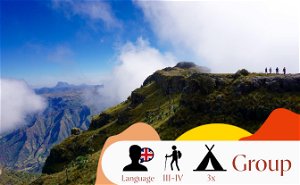
Small Group Simien Mountains Trekking
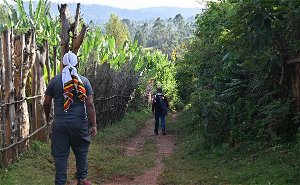
Short Community Hiking in Gurage Ethiopia
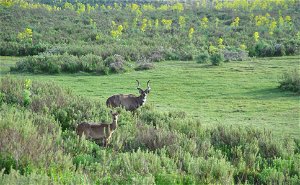
Trekking Adventure in The Bale Mountains
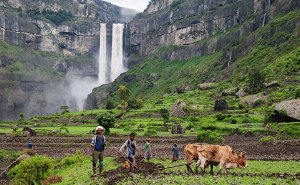
Hiking adventure to the impressive Zala Waterfall
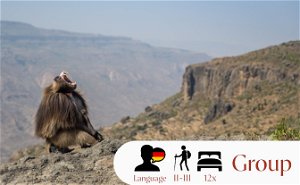
Mysterious Ethiopian Nature & Culture
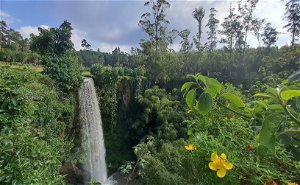
Community Hiking in Ethiopia's Green Gurage Zone

Hiking the Lasta Mountains in the surroundings of Lalibela

Hike through the unknown and remote part of the Simiens

Hiking & Culture - Relaxed travels through Northern Ethiopia

Trekking and Elephant sightings in Northern Ethiopia
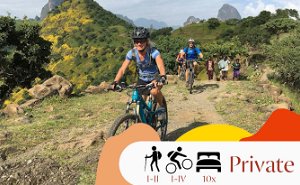
Bike & Hike the Ethiopian Highlands

Community Hike through the Wof Washa Forest
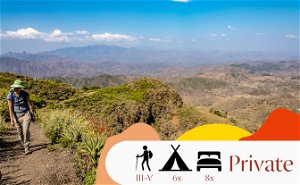
Trek the highest peaks at the Horn of Africa
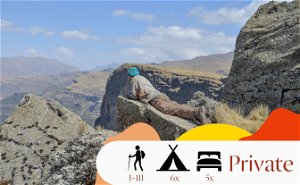
Hiking on the 'Roof of Africa' in the Simien Mountains

Hiking & Wildlife in the Jamma Canyon
Exclusive offers.

Share This Page
Trekking Ethiopia's Simien Mountains
Sep 22, 2016 • 4 min read
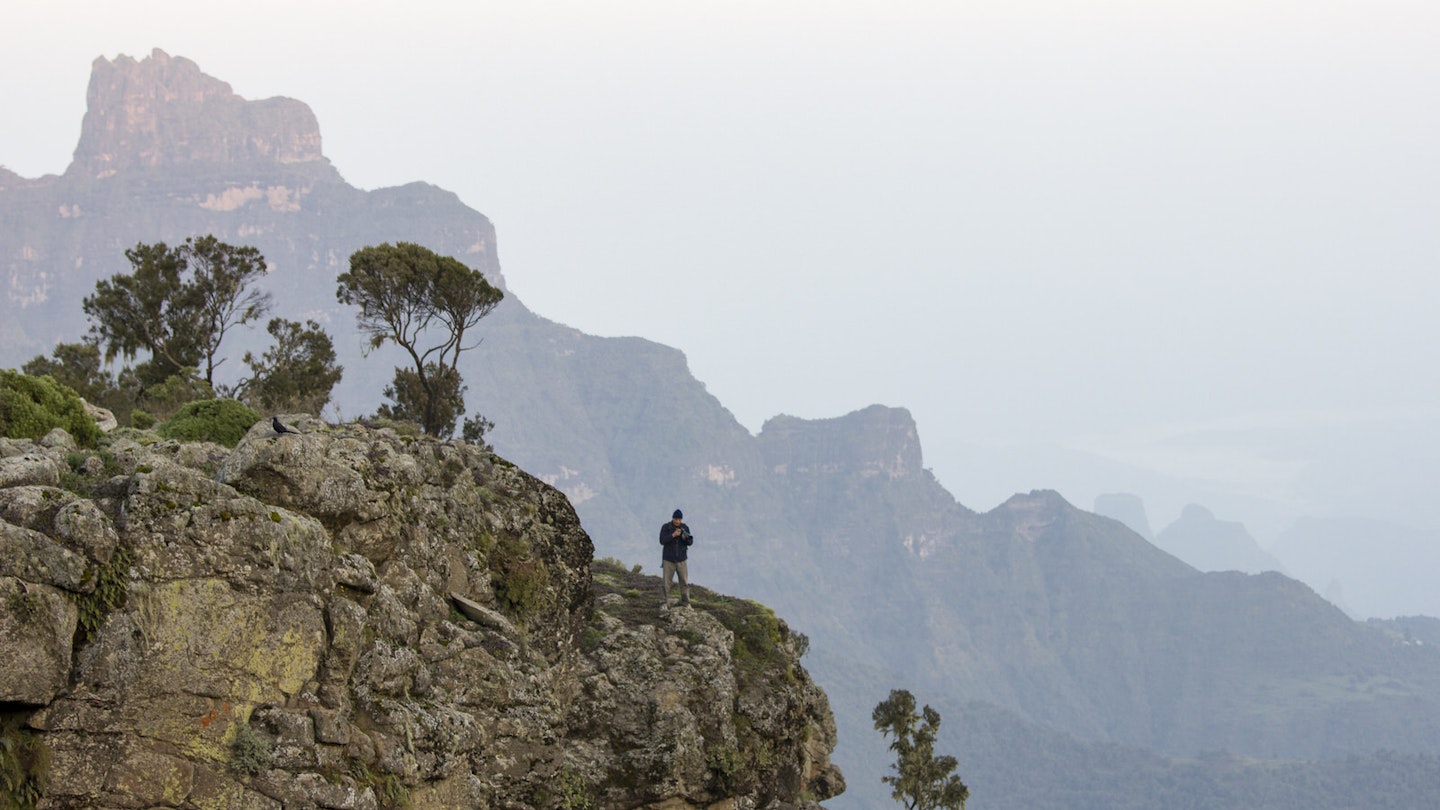
Simien Mountains trekking
Ethiopia is a land of legends and mystery – the Queen of Sheba and the Ark of the Covenant to name but two. The landscape is also mesmerising. In the far north are the Simien Mountains – a mystical world of primeval forests, misty peaks, bizarre plants and exotic creatures. Trekking these stunning highlands is like stepping into an otherworldly paradise.

Dramatic landscapes
Violent volcanic eruptions 40 million years ago created the Simien Mountains massif, which rises to over 4500m in northern Ethiopia . Over millennia, erosive forces have sculpted its jagged pinnacles, deep ravines and volcanic plugs. Treks of between five and ten days along high-altitude escarpments, across alpine meadows and through the fertile lowlands are the best way to fully appreciate the amazing diversity of the Simiens, much of what today is protected as part of Simien Mountains National Park .
Steep ascents lead to lush plateaus populated with giant lobelias – freaky fleshy-leaved plants growing to 3m in height, evoking images of dinosaurs and ancient days. Escarpment vistas are filled with sheer cliffs, plunging waterfalls, and rocky turrets spiking out from the forested valleys below. Ribbons of mist drift over the ground. Vultures and ravens cruise the skies. It is a strangely beautiful yet primal world.

Dropping off the escarpment, the landscape undergoes a dramatic transformation as it descends some 2000m into the lowlands – lowlands being a misnomer given these valleys are still over 2000m in altitude. Vibrantly coloured red hot poker plants cover the mountain slopes, and desert-style cactus trees and groves of aloe vera line the trail. Cultivated fields of yellow canola flowers and feathery green tef are peppered with tropical-style giant ficus and palm trees.
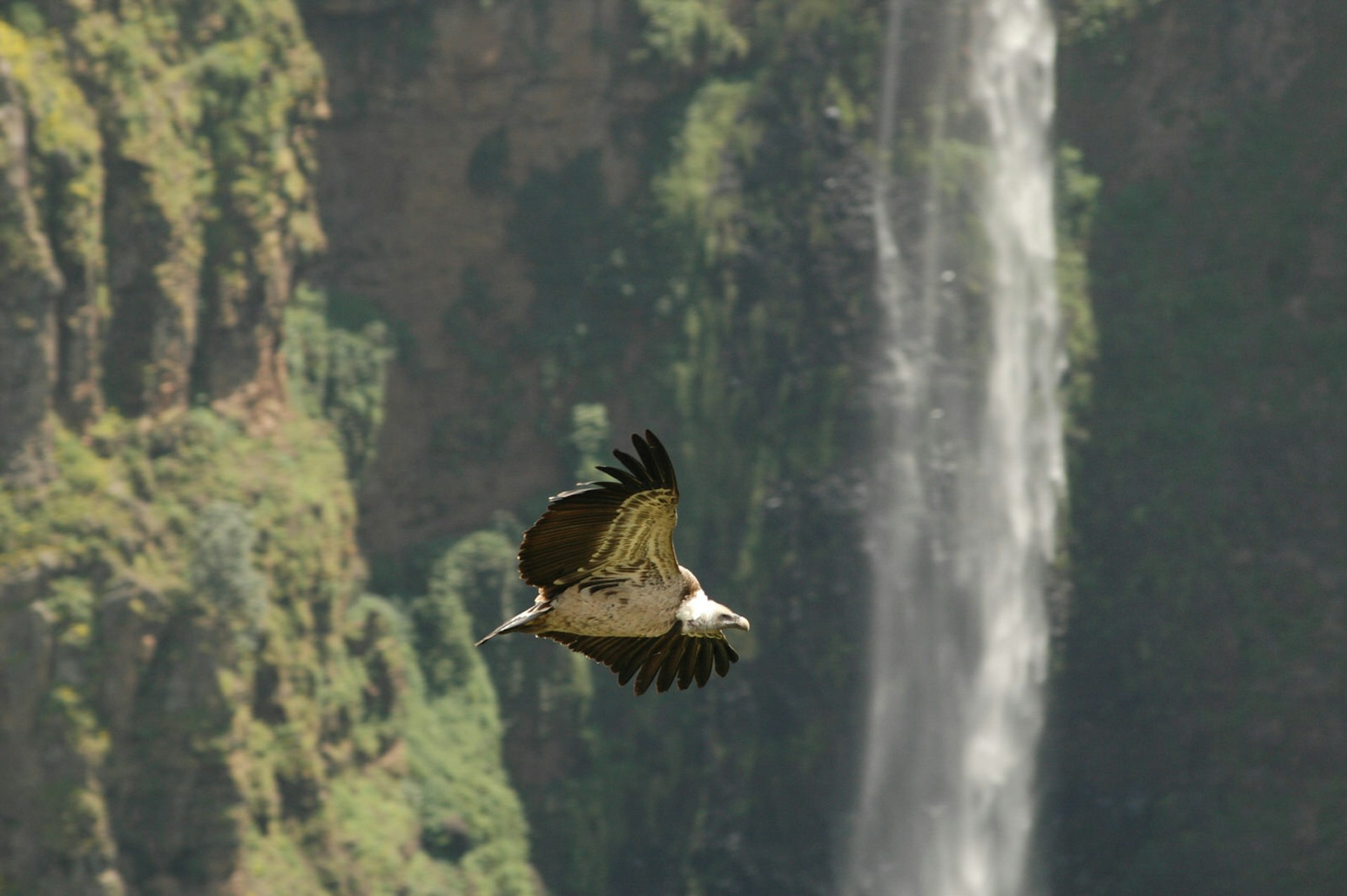
Endemic wildlife
Living in the highlands of Ethiopia is a rare and exotic cache of wildlife – the gelada (aka 'bleeding heart baboon'), the elusive Ethiopian wolf, the majestic Walia ibex and the giant Lammergeir (a bearded vulture with a 3m wingspan). There’s a good chance of spotting all of these creatures, and more, on a trek through the Simien Mountains.
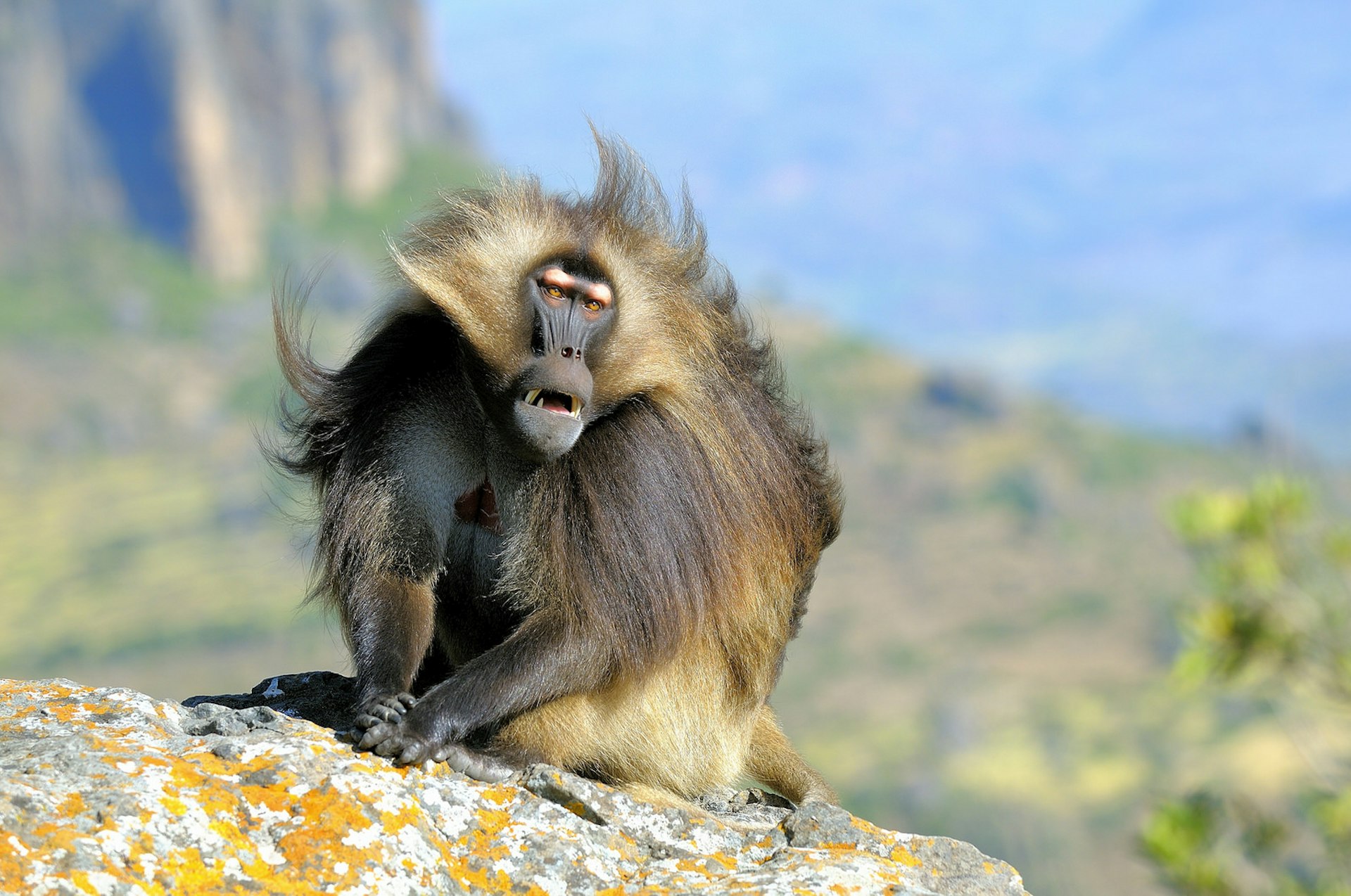
With their expressive faces, playful antics and magnificent silver manes, the geladas are simply delightful. Once almost hunted to extinction, these monkeys (babaoons is a historical misnomer) are now a protected species. The gelada is found only in the Simiens. They live in groups of one hundred or more, and favour the escarpment where they clamber over and under the cliff edge like agile acrobats. Unlike most primates that advertise sexual receptivity with swollen red buttocks, the gelada has a scarlet patch of skin on its chest, which led to its ‘bleeding heart' moniker. It is easy to approach within a few metres of these wild animals, especially those found around Sankabar (3600m) and Chenek (3620m).
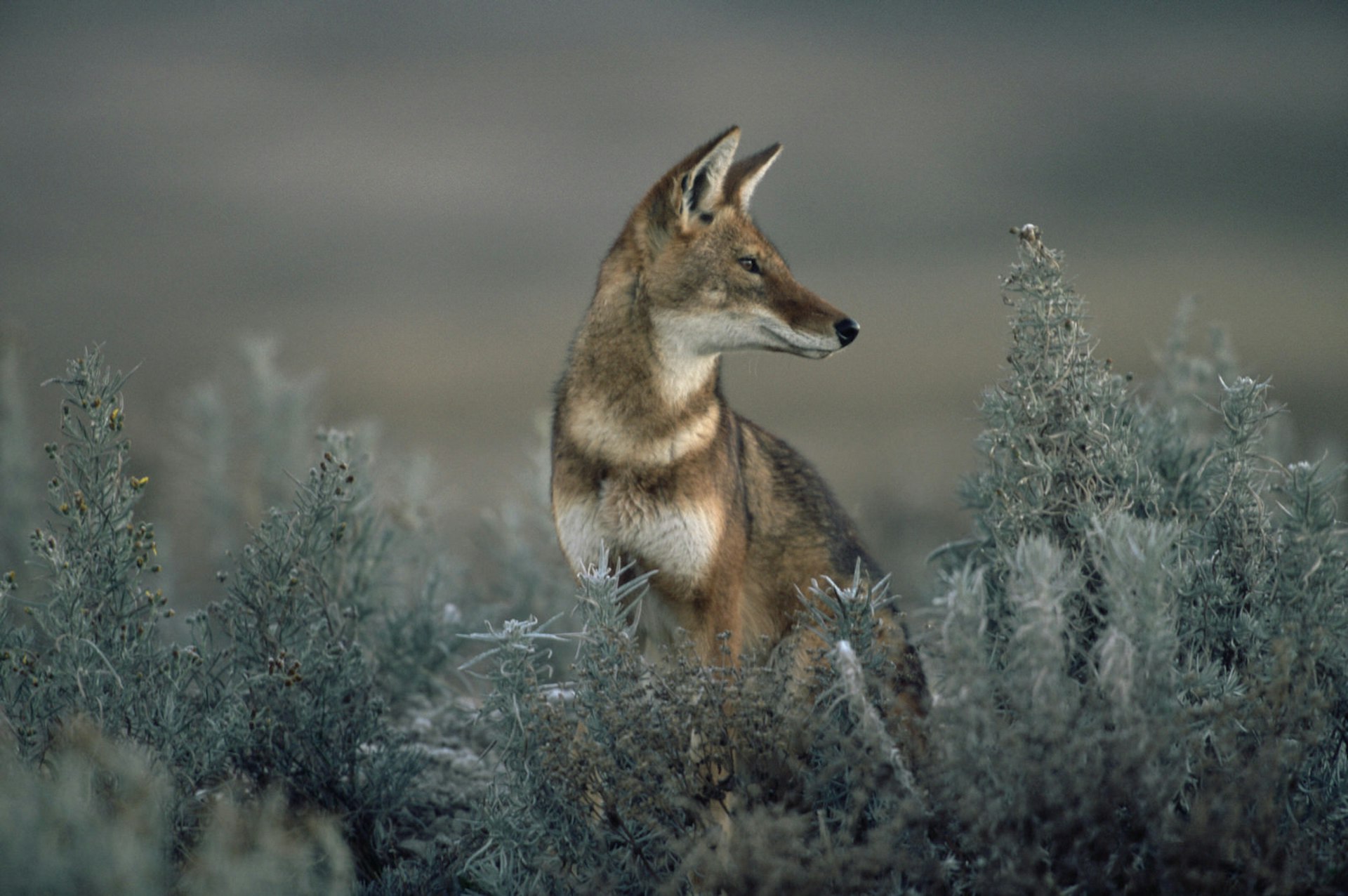
The Ethiopian wolf, or Simien fox, is extremely rare. In fact it is the planet’s rarest canid, with an estimated population of less than 50 in the Simien Mountains, and no more than 400 in the entire country (the majority reside in Bale Mountains National Park in southern Ethiopia ). The main threat to the wolf’s survival stems from habitat destruction due to agricultural expansion into the afro-alpine zone. Habitat depletion has also impacted the endangered Walia ibex, another species endemic to this region. Looking like a large deer with impressively long, ridged horns, it is actually a member of the goat family. Liking steep, rocky places, they might be found at Chenek grazing the vertical cliffs below the escarpment.

The roof of Africa
Due to its scope and size, the mighty mountain massif of the Simien Mountains is poetically called the ‘roof of Africa’. Ras Dashen, at 4543m, is Ethiopia’s highest peak and its crowning glory.
Trekking to the summit is challenging but not technical. Summit attempts generally launch from the local village of Ambiko (3170m) on the Meshehe River. And in true summit day fashion, hiking starts well before dawn. The first few hours are cold and dark and wrapped in silence. Headlamps highlight a trail leading steadily upwards for 10km through farmland, giant lobelia forests and alpine meadows. Finally, after six hours of continuous climbing, a short scramble up a rocky wall leads to the summit. The view is outstanding – a rich panorama of peaks and gullies, farmlands and forests stretching into the distant haze of Eritrea. Standing on top of Ethiopia’s highest peak is...well, like standing on the roof of Africa.
Make it happen
The driest time of year for hiking is from December to March but at the end of the rainy season, in October, the land is a riot of green. Wildflowers bloom in August and last well into October.
Organised trekking tours take care of the hassles – equipment, permits and supplies – but independent trekking is not too difficult to arrange. Everything can be organised at the Simien Mountains National Park headquarters in Debark: paying entrance fees, arranging drop-offs and pick-ups at trail access points, hiring camping equipment, guides, scouts, cooks and mules.
Park regulations require scouts (armed park rangers) to accompany trekkers even though the greatest danger is altitude sickness. The scouts are fit and wiry, often war veterans from past battles. With AK-47s slung across their shoulders, they saunter up steep hillsides in their ill-fitting plastic sandals, and willingly brandish their rifles for happy snaps.
Explore related stories
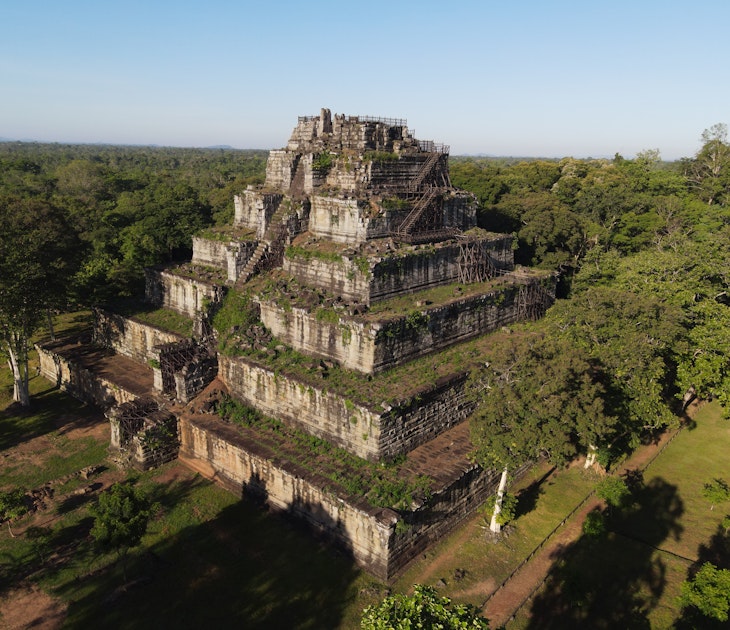
Wildlife & Nature
Sep 28, 2023 • 6 min read
Spanning five continents, the newest entries on Unesco’s list of World Heritage sites celebrate natural treasures and human ingenuity.

Mar 8, 2023 • 7 min read
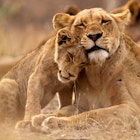
Sep 8, 2022 • 7 min read
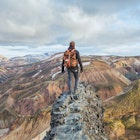
Jan 25, 2022 • 8 min read
Aug 3, 2021 • 8 min read

Nov 30, 2020 • 5 min read
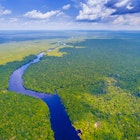
Sep 24, 2020 • 5 min read
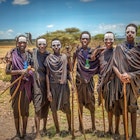
Aug 4, 2020 • 4 min read

Jan 29, 2020 • 9 min read
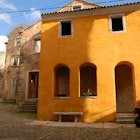
Jan 8, 2020 • 8 min read
- United Kingdom
- Ethiopia Travel
- Places to Go
- Simien Mountains National Park
- Trekking & Hiking

Trekking in the Simien Mountains
Ethiopia has some of the best trekking routes in Africa. The Simien Mountains National Park is the most popular trekking destination in the country. A combination of stunning viewpoints, luxury lodges, epic hiking trails and endemic wildlife make it one of the most exciting mountain ranges in the world.
Choosing the right trek
It is possible to spend up to two-weeks trekking in the Simien Mountains . Two lodges and nine campsites give you access to the majority of the mountains, and a number of village home-stays to the lowlands north of the park, and to community treks to the south, means there is a huge range of hiking experiences available.
Choosing the right base, duration, and routes can make a big difference to your overall experience in the Simien mountains.
Popular Treks in the Simien Mountains
Camping in the simien mountains.
The classic 3-night camping circuit in the Simien Mountains. This trip is usually included as part of a wider itinerary in the country.…
Classic Simiens Safari
The Simien Mountains are one of Ethiopia’s most stunning destinations. With its diverse flora and fauna, immense views and extraordinary geography, it’s an exceptional place that can be enjoyed by hardy trekkers and afternoon strollers alike. A couple of nights…
Simien Mountains and Northern History
This trip packs in a myriad of history, culture and some of the best scenery in Africa. Explore the palaces of Gondar, the world-famous rock-hewn churches in Lalibela, and the sweeping plateaus of the Simien Mountains. Leave enough time either…
2 Day Simien Trek
An introduction to the Simien Mountains, this 2 day trek takes you to some of the major viewpoints of the primary escarpment, with one night spent camping at the beautiful Gich campsite.…
3 Day Simien Trek
This 3 day Simien Trek is the perfect introduction to the national park. Enough time to hike to all the major viewpoints, see the wildlife, and enjoy the beauty of these highlands.…
4 Day Simien Trek
This 4 day trek in the Simien Mountains starts and ends in Gondar. Hike from camp to camp, across the sweeping plateaus and down into the valleys.…
6 Day Simien Trek
6 days trekking in the Simien Mountains, across the vast plateaus and down into the valleys to discover some of the most exciting regions of the park. A proper wilderness escape.…
Discover the beauty of the Simien Mountains with this one week trekking adventure. Our Brilliant local guides know all the hidden gems to get the most out of your time on the 'Roof of Africa'. Easy to incorporate into a…
Historic North & Christmas in Lalibela
Kicking off on 5th January, this tour takes you on a journey through Northern Ethiopia, from the Simien Mountains to the castles of Gondar. What's more, you'll get to experience Ethiopian Christmas in Lalibela, one of the most extraordinary celebrations…
Historic North and Luxury Lodges
Experience Ethiopia's northern circuit in style. Explore the incredible highland scenery, visit ancient monuments, discover unique cultural traditions, and break up your journey at luxury lodges set amongst incredible backdrops.…
Historic North Circuit
Explore the Simien Mountains from a luxury lodge perched high in the escarpment, discover the architectural remains of ancient civilisations, and watch the sun set over the sandstone cliffs of Tigray. The Historic North Circuit is a flagship itinerary in…
Historic North Circuit and Community Trekking
Fusing history, culture, landscapes and wildlife along a perfectly paced circuit, this trip is a synthesis of the very best experiences on offer in Ethiopia’s northern highlands. Explorations of the ancient cities Axum, Gondar, Bahir Dar and Lalibela are broken…
Peaks and Plateaus of Ethiopia
Community trekking in Wollo and Tigray and hiking through the Simien Mountains National Park highlight the staggering natural beauty of Ethiopia. Tours of the ancient cities of Bahir Dar, Lalibela, Gondar and Axum play supporting roles.…
Explore the Roof of Africa
Experience the breathtaking Simien Mountains National Park on this in-depth tour of the ‘Roof of Africa’. Trek to peaks breaching 4,000 meters, experience the panoramic vistas, cross the rivers that flow into the lowlands and get up close with endemic…
Taking a break to admire the view.
An armed scout must accompany you in the Simiens.
Imet Gogo is a stunning viewpoint in the Simiens.
Sitting amongst Geladas and Juniper trees.
The incredible view from the Imet Gogo viewpoint.
Troops of Gelada Monkeys on the cliff-edge near Sankaber.
Cliff-edge treks towards Chennek.
Fields of Gelada Monkeys play near Simien Lodge.
The epic Jinbar waterfall, a 500m plummet to the Gich Abyss.
Princess stop and the views around Limalimo Lodge.
View from Imet Gogo - day 2 of the Simien trek.
The 'bleeding heart' Gelada Monkeys - symbol of the Simiens.
Raptors soaring in the thermals and the jagged Simien peaks.
Geladas racing across the open fields near Sankaber.
On a clear day, the views are an amazing display of light and shadow.
The Gelada Monkeys are used to trekkers, so you can get up close.
Tom on the 'Roof of Africa'.
Peaks and valleys of the Simien Mountains.
Sankaber campsite - the first stop on the classic Simien trail.
Hiking along the escarpment edge in the Simiens.
Views from the Limalimo self-treks.
The Simiens are dubbed the 'Roof of Africa' - and for good reason.
A short self-trek from Limalimo takes you to this beautiful clearing.
Giant Lobelia Trees in the Simien Mountains.
Gelada Monkeys are endemic to Ethiopia.
The sprawling, jagged, epic Simien landscape.
Mountain goats roaming around at 3,000 metres.
Trekking along the plateau edge towards Gich.
Lobelia trees encompass the Chennek campsite.
Lobelia Trees on the ascent hike towards Chennek.
View from the deck at Limalimo Lodge.
Taking a break at Imet Gogo.
Contents of our guide
- Trekking routes in the Simien Mountains
- Arranging Permits & Scouts
When to visit the Simien Mountains
- Trekking in the Simiens FAQs
Lodges in the Simien Mountains
How to get to the simien mountains, popular trips to the simien mountains.
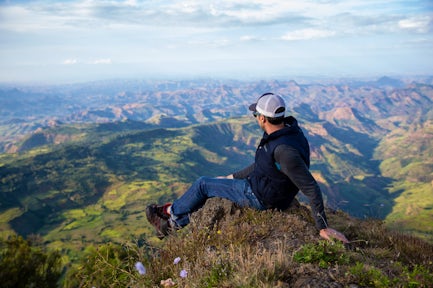
Trekking Routes in the Simien Mountains
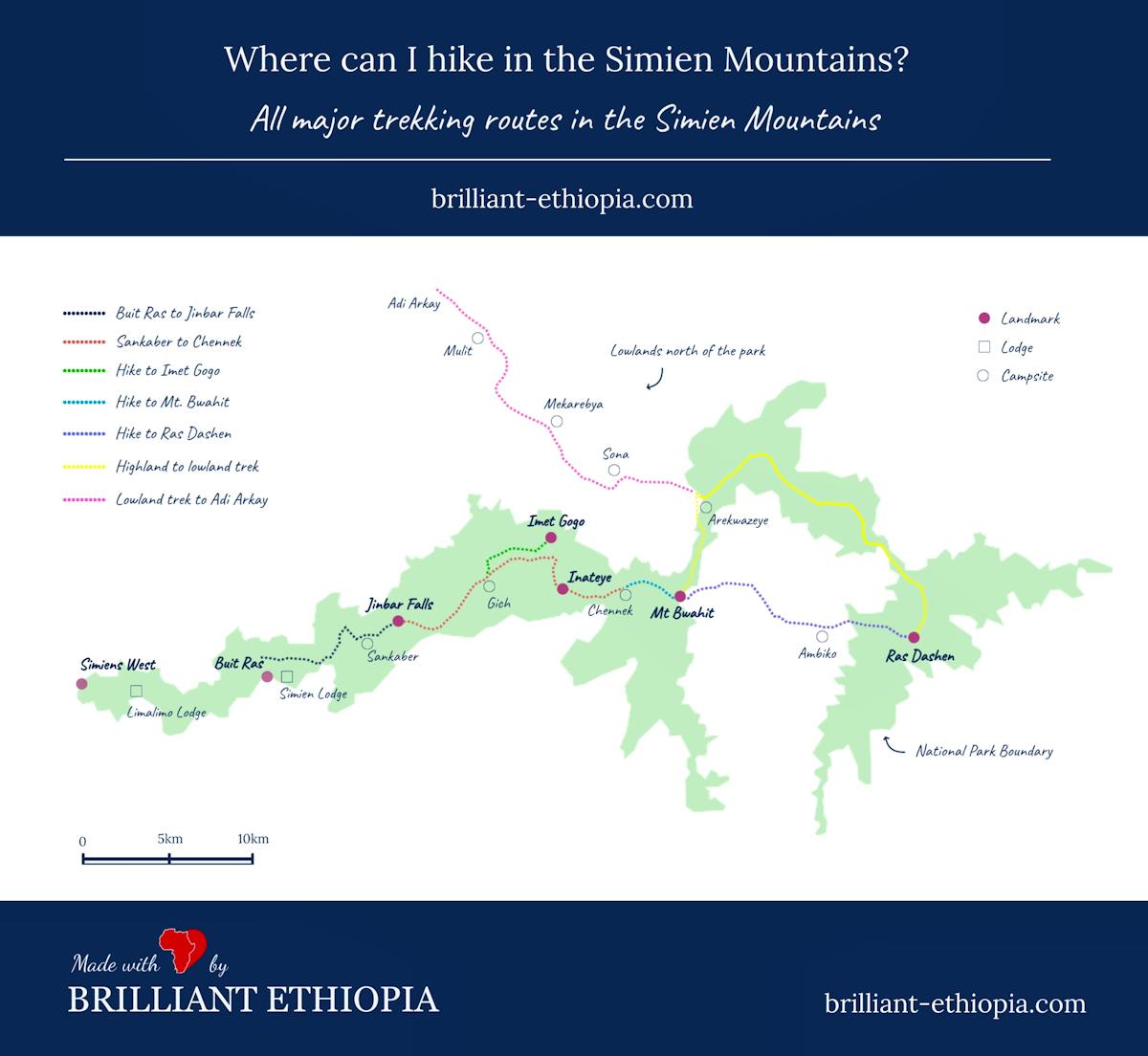
Most Popular Treks
Buit ras to sankaber and the jinbar falls.
If you are camping in the Simiens, Buit Ras will likely be your drop-off point. From here, an acclimatization hike takes brings you to Sankaber , the first campsite for most Simien treks. If you are staying in Limalimo Lodge or Simien Lodge , you can drive directly to the lodges first, and then take a transfer into the park to join some of the trails, or to stop off at the best viewpoints.
A popular landmark on the first day of a Simien trek is the Jinbar Falls , where the Jinbar river plunges 500m down into the Gich Abyss. The waterfall is very seasonal, and particularly impressive in and after the rainy season (July - November). In the drier months, the flow is significantly reduced, but it is still a remarkable sight.
The hike from Buit Ras to Jinbar falls follows relatively even terrain across the escarpment edge with great views. Troops of Gelada Monkeys, sometimes numbering in the hundreds, might be spotted and you can often go and sit near them and watch them as they eat and play. The hike lasts about 3 hours , but can be shortened by vehicle if needed.
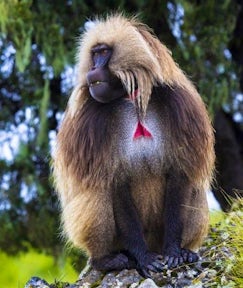
Sankaber to Chennek
Sankaber, Gich, and Chennek connect across the primary escarpment of the Simien Mountains, and a popular trekking option is a 3-night hike from camp to camp. The route across the escarpment has exceptional viewpoints with stunning 360-degree views and lots of wildlife . There are plenty of optional hikes to other peaks, to see wildlife and to take in other landmarks depending on your fitness levels and interests.
Chennek is a highlight of the park. Set in a stunning area with views of the surrounding escarpment and out onto the lowlands for miles into the distance. Chennek is also one of the best places to spot the Walia Ibex and, if you’re very lucky, the Ethiopian Wolf .
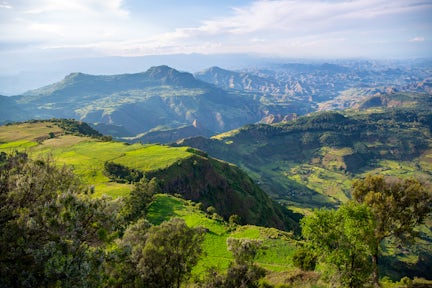
Imet Gogo , at 3,926m, is one of the most beautiful and popular viewpoints in the Simien mountains. Imet Gogo can be accessed via a somewhat challenging hike from Gich campsite. The summit offers panoramic views of the entire Simien range, and if you look east you will see the towering Ras Dashen (Ethiopia’s highest peak) in the distance.
The trek is about 5-6 hours for the round trip with some steep ascents - it’s one of the highlights of the Simiens, and we’d definitely recommend giving yourself time to include it. The trail begins with a descent hike that takes you down into the Jinbar river valley, before ascending up towards Imet Gogo, finishing along a ridge with exceptional views on both sides.
Check out the video we took from Imet Gogo below...
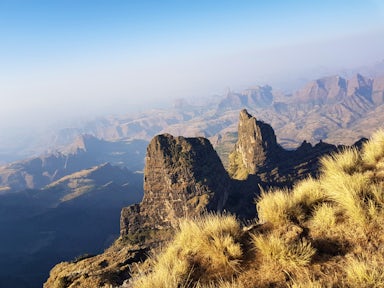
Views from the Simien Mountains.
Inateye is a wonderful viewpoint accessed on the approach trek from Gich to Chennek. Inateye sits at 4,070m, and has amazing views of the Bwahit pass to the east, Imet Gogo to the north, and the surrounding escarpment. Inateye is a hot-spot for birds; raptors soar in the thermals below and you’ll likely also find tawny eagles and lammergeyer here. From the summit of Inateye, it is a 3-hour onward trek to Chennek.
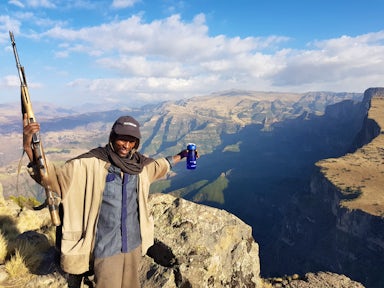
Challenging Peaks
Bwahit peak.
Bwahit is the highest peak on the western side of the Simiens at 4,430m (second only to Ras Dashen, which stands just 110m higher). The trek starts from Chennek and takes 4 hours for the round trip. Although shorter in distance than many of the other Simien trails, the altitude can make the hike quite challenging.
Chennek is the best spot in the park to see Walia Ibex, and your chances of seeing them are much higher if you’re trekking all the way to Bwahit peak. The route to Bwahit passes sprawling fields of Giant Lobelia trees , and as you ascend above the clouds, the terrain often becomes covered by a mist.
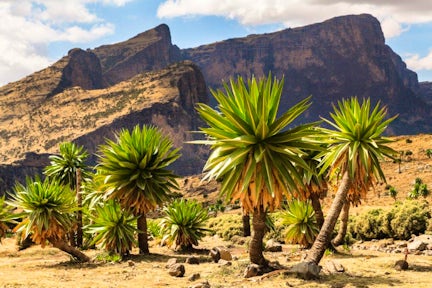
The Ras Dashen summit hike is the most challenging trek in the park. It is not possible to hike to Ras Dashen via sortie into the park from a lodge as the peak sits to the east of the primary escarpment and so you need to camp at the base camp at Ambiko.
The full trek can last up to 12 hours , with around 7 hours for the ascent hike and 5 hours for the descent hike. While there are some steeper gradients, the majority of the trail follows a relatively even ascent, but the ever-increasing altitude and the overall duration of the hike makes it very challenging. You will need to be quite fit for this hike.
Standard treks to Ras Dashen will start and end in Ambiko. With our partners, we can arrange more adventurous routes taking you down a different trail.
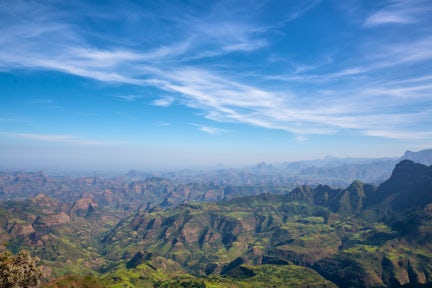
More Peaks in the East
For those who want a challenge, there are some high peaks on the eastern side of the park. Ras Dashen is the most famous of these, but a close second is Kidus Yared (4,453m) . A number of other peaks in this area can be considered subsidiaries of Ras Dashen and Kidus Yared.
For a challenging hike, you can start a trek from Ambiko to Rash Dashen, then hitting Kidus Yared before a ridge walk takes you to the craggy peak of Abba Yared (4,409m) , and then descending to the camp at Arekwazeye. If you are exceptionally fit and start early, you might also manage to hit the peak of Silke (4,420m) too.
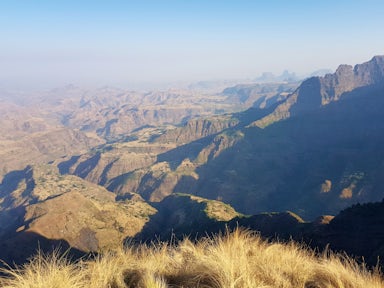
Further Afield
Treks north towards sona.
For those spending 7+ days in the park who plan to complete the full Simien circuit finishing at the lowland village of Adi Arky north of the park, there are two routes that follow the escarpment edge towards Sona, where the lowland trekking begins .
The first route is shorter and runs from Chennek or Mount Bwahit north towards the campsite at Arekwazeye. The second route follows from Ras Dashen in the east of the park and skirts the escarpment edge all the way around to join at Arekwazeye. This trail is about 7 hours and there are some fantastic viewpoints along the route, including Kidus Yared, Silki, Waliakend, and Berochwuha.
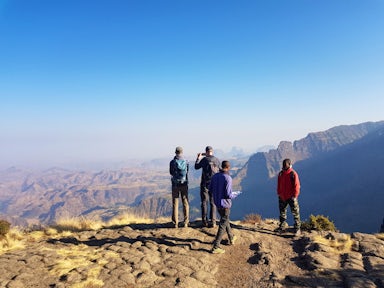
Lowland Treks from Sona
To the north of the park, a series of campsites and village stays run through a rural countryside towards Adi Arkay, the northernmost village of the Simien circuit and the finishing point for the lowland treks.
Hiking here is a very different experience than in the highlands of the main escarpments, and it is a wonderful way to learn about the local way of life and meet local people, whilst enjoying the incredible views and starry nights. Temperatures along the trail are much warmer due to the lower altitude, making the evenings more pleasant.
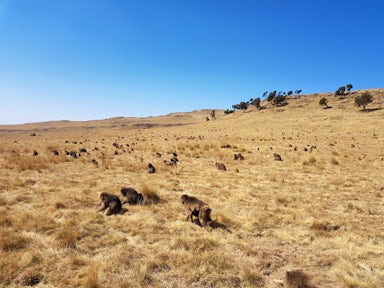
Community Trekking
If you are a trekking enthusiast, or keen to see the local farming culture in the highlands, you can spend a few days on a community trek in the Simiens.
Set in the farm land just south of the park, you are hosted in simple huts built by the locals just outside their village. Your bedrooms, round tukuls, have mattresses on raised bases. There are simple sit on latrines with plastic seats, and the locals prepare basic meals for you. You will have local trekking guide (generally okay English).
Don't expect a lodge, it is basic and remote, but you will experience the genuine hospitality of the highlanders. This can be dovetailed with a visit into the main park itself - but both are very different and equally fantastic experiences. The community trek is ideally a 4 night trip and supports the local communities who own the guesthouses.
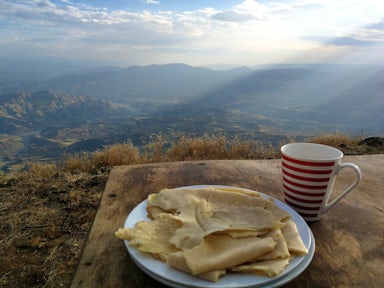
Arranging Permits & Scouts
All visitors to the Simien Mountains National Park must first stop at the entrance town of Debark to collect permits and arrange your guide and scout services. It is mandatory that a qualified guide and scout accompany you while trekking in the Simien Mountains (all of this will be handled for you as part of your booking with us).
Debark is your final stop before entering the national park, so it is a good idea to stock up on any essential supplies here. There are a couple of ATMs in the town if you need to withdraw some cash.
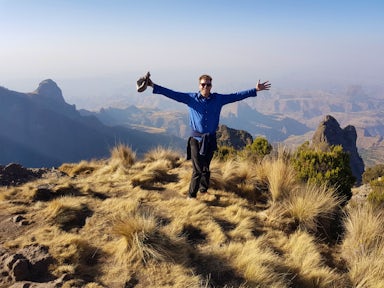
The best time to visit the Simien Mountains is between October and March , with the clearest skies and warmest weather. December, January, and February is the peak travel season, meaning the campsites could be busy, but you have the best weather conditions (although changes in climate patterns mean the rainy/dry season is less reliable so you should be prepared for rain at any time). The rainy season in the northern highlands of Ethiopia runs from June to August , with showers often extending into the first half of September.
You can learn more on our ultimate guide on when to visit Ethiopia .
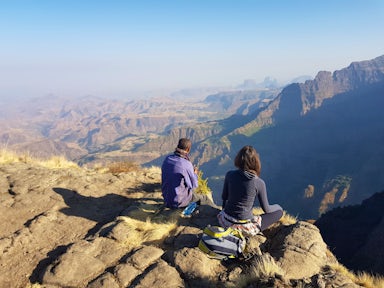
Trekking in the Simien Mountains FAQs
Do i need to worry about altitude sickness.
Altitude sickness is a real possibility in the Simien mountains, although instances are rare for most visitors with some experience at higher altitudes. If you have a history of altitude sickness or other pre-existing health conditions that may put you at higher risk, please consult your doctor or travel health nurse to help determine whether the Simien mountains are an appropriate for you.
It is important to be aware that the Simiens are in a rural part of the country, and the nearest health facility is many miles away by road. You must arrange adequate travel insurance before departing to Ethiopia, and consult your doctor to understand the risks involved for you.
Staged increases in altitude is extremely important to avoid altitude sickness. It is important that you do not fly into Ethiopia and immediately head to one of the higher camps. It is much safer to acclimatise in Addis, Gondar, or Lalibela for a few days before heading into the Simien Mountains.
How fit do I need to be?
Trekking in the Simien mountains is not limited to the super fit or athletic. A road running through the primary escarpment of the mountains allows you to take sorties into the park, and simply stop off for short hikes to the best viewpoints and landmarks.
Guides can also help to carry gear or show you the most accessible routes. While you don’t need to be in amazing shape to enjoy the Simien mountains, it is important to keep in mind that you will be above 3000m most of the time, so even short walks can become tiring.
For those that are fit and active, there are some more challenging treks you can enjoy if you want to push yourself.
What do I need to bring?
Please see our full Simien trekking kit list below:
The essentials
- Waterproof jacket/raincoat/windbreaker and jumper for the evenings.
- Good quality, robust, waterproof trekking shoes or boots.
- Light waterproof trekking pants or trousers. Shorts are a good option as well on warmer days.
- Sunglasses.
- Soft day bag (backpack).
- Toilet paper and/or wet wipes.
- Comfortable T-shirt. If you're visiting in the rainy season, a long sleeve trekking T-shirt (ideally Dri-FIT or similar) is a better option.
- Cap or hat.
- Filtration water bottle (please don't use plastic).
The nice-to-haves (guides can provide much of this for you)
- Binoculars.
- Sleeping bag.
- Nordic walking stick.
- We also recommend bringing a few sachets of rehydration salts. Water is provided for the treks but you can often find yourself dehydrated after a full day of trekking and the salts can provide quick relief.
The different operators offering trips into the Simiens have different standards - it’s well worth booking one of the better ones to ensure you have the right gear and good food on your trip.
Tents, sleeping bags and mattresses can vary in quality depending on who you choose and with sub-zero temperatures, poor gear can make things uncomfortable.
What equipment do I need?
If you are camping in the mountains and have booked a trip through Brilliant, then all camping equipment and food will be provided for you for your treks. However, we do recommend that you bring your own sleeping bag, or check your gear before leaving Debark to ensure you’ve plenty of what you need. Sometimes the sleeping bags, or mattresses can be thin for some people and you might want to bulk up on blankets or double up on gear.
Given the altitude, the temperature in the Simiens often drops below freezing at night and the equipment you have can make all the difference between an enjoyable or an uncomfortable stay. You should definitely also bring warm clothes for the evenings and night-times.
Your main luggage can be stored securely at a hotel in Gondar if you are returning there after your Simien trek, or you can keep them in our vehicles if you are not returning to Gondar. Where this is not possible, luggage is transported by mules from camp to camp, so it is easier if you bring soft bags rather than hard suitcases.
If you are staying at a lodge, then all your luggage can be stored securely at the lodge and you can simply take out a day bag with you on the treks.
Do I need to bring any specialist equipment?
No, the trekking routes in the Simien mountains are not technical - so as long as you have the basics you will be fine. Walking sticks and ankle supports can be helpful if you are able to bring them, or need them.
Where should I stay?
There are two lodges in the park and nine campsites. You can therefore choose camp-only treks, lodge-only treks, community-run treks (south of the park) or a combination. Which is best for you will depend on your fitness levels, interests, budget, and time constraints. For more information, check out our guide to choosing the right accommodation in the Simien Mountains .
How long should I spend in the park?
The most popular trip is a 2 or 3-night stay based at either Limalimo Lodge or Simien Lodge , or camping from Sankaber to Chennek over 3 nights (often with a night or two at Limalimo Lodge tagged on at the end if you have more time available). The full Simien circuit from Buit Ras all the way to Adi Arkay in the north can take up to two weeks.
It is possible to do a day trip into the park, but the experience is more limited. You can see the large troops of Gelada Monkeys, and get to see some of the stunning viewpoints, but you will spend a lot of the day on the road starting out the windows of a Toyota Landcruiser.
It is possible to climb Ras Dashen with a 5 day/4 night trip, but it's tough going and does not give you much time to adjust to the altitude. The trekking team will also charge a minimum of 8 days for this trip.
Do I need a guide?
It is highly recommended. It's sensible to book ahead as if you just show up you will get whichever guide is available that day, and many are not as professional or knowledgeable as you would like.
If you are visiting independently, it is not mandatory to take a guide (although you will be pressured into taking one). However, it is mandatory that a scout accompanies you in the mountains. If you visit independently and go with a scout only, you will face a language barrier as scouts tend to have very little English.
If you are coming with a tour operator, then a guide and scout is mandatory.
There are detailed regulation as to how many cooks, cook assistants, scouts, guides etc. a group must take - there are even position like 'tent erector'! You will have quite a team accompanying you, your muleteers and mules!
All visitors to the park must first arrange entrance fees, guides, and scouts at the entrance town of Debark. If you book through us, all of this is taken care of for you.
How much does it cost?
Given the variety of treks and accommodation options available, the price for a Simien trek depends mostly on the whether you choose to stay at a lodge instead of camping, and how long you want to spend in the park. Get in touch with us for more details or to arrange a quote.
Can I combine the Simiens with other destinations?
Absolutely. The Simien Mountains is part of the classic northern circuit of Ethiopia. Ethiopian Airlines’s domestic flight network makes it easy to connect into the gateway town of Gondar from anywhere in the country, and from there it is a 2-hour drive to the national park.
Although not always included in the northern circuit, it is also easy to combine the Simiens with a trip into the Danakil Depression .
If you want to combine the Simiens with regions in southern Ethiopia like the Omo Valley or Bale Mountains , keep in mind that you need at least 4 days to explore the Omo Valley, and 2-3 days for the Bale Mountains. If you're combining these destinations with the full northern circuit, you'll need at least two weeks.
Are meals & water included?
If you are on a camping trip, all meals, water and snacks are included. However, in the interest of the environment we are trying not to use packed bottled water. This will also save on the size of your mule train! We recommend that you bring filtration equipment (a small filtering water bottle or pump). The team can then just bring a jerrycan or two and even fill up from the natural spring water (and it is safe if you have a filtration system).
At Limalimo Lodge, all meals and mineral water are also included. Note that the menu is fixed but they will adapt to your requirements if you tell them in advance). Limalimo have their own filtered water and bottles of local drinks. Wine from the Rift Valley (highly recommended!), beers, and local G&T are also included. If you are staying at the Simien Lodge, food and drink are not included but there is a good a la carte menu for each meal.
What is the weather like?
The Simien’s rainy season starts in June and runs into the first half of September. The best months for trekking are from October to March. Check out our guide on when to visit the Simien Mountains for more information.
Is the park suitable for families?
Absolutely. Short, kid-friendly hikes can easily be arranged. If you are coming as a younger family, it usually makes more sense to base yourself at Limalimo Lodge or Simien Lodge . Older children used to camping will enjoy the adventurousness of the treks and time around the campfire in the evenings.
There are nine major campsites in the Simien Mountains. The most popular, Sankaber, Gich, and Chennek sit along the primary escarpment of the park. A typical trek starts from Sankaber and winds across the escarpment to Gich and then on to Chennek. The route from Sankaber to Chennek itself is extraordinary, with many fantastic viewpoints along the way. If you want to push yourself, there are also a number of optional hikes to some higher peaks.
For those who want to spend longer in the park, do some tougher trekking, or simply experience more of what these mountains have to offer, there are a further seven campsites beyond Chennek which will often be less busy than those on the main routes. These take you far beyond the primary escarpment, across the Bwahit Pass towards Ras Dashen, and then out northwards towards Adi Arkay across the lowlands and rural farmland.

Campsites in the Simien Mountains
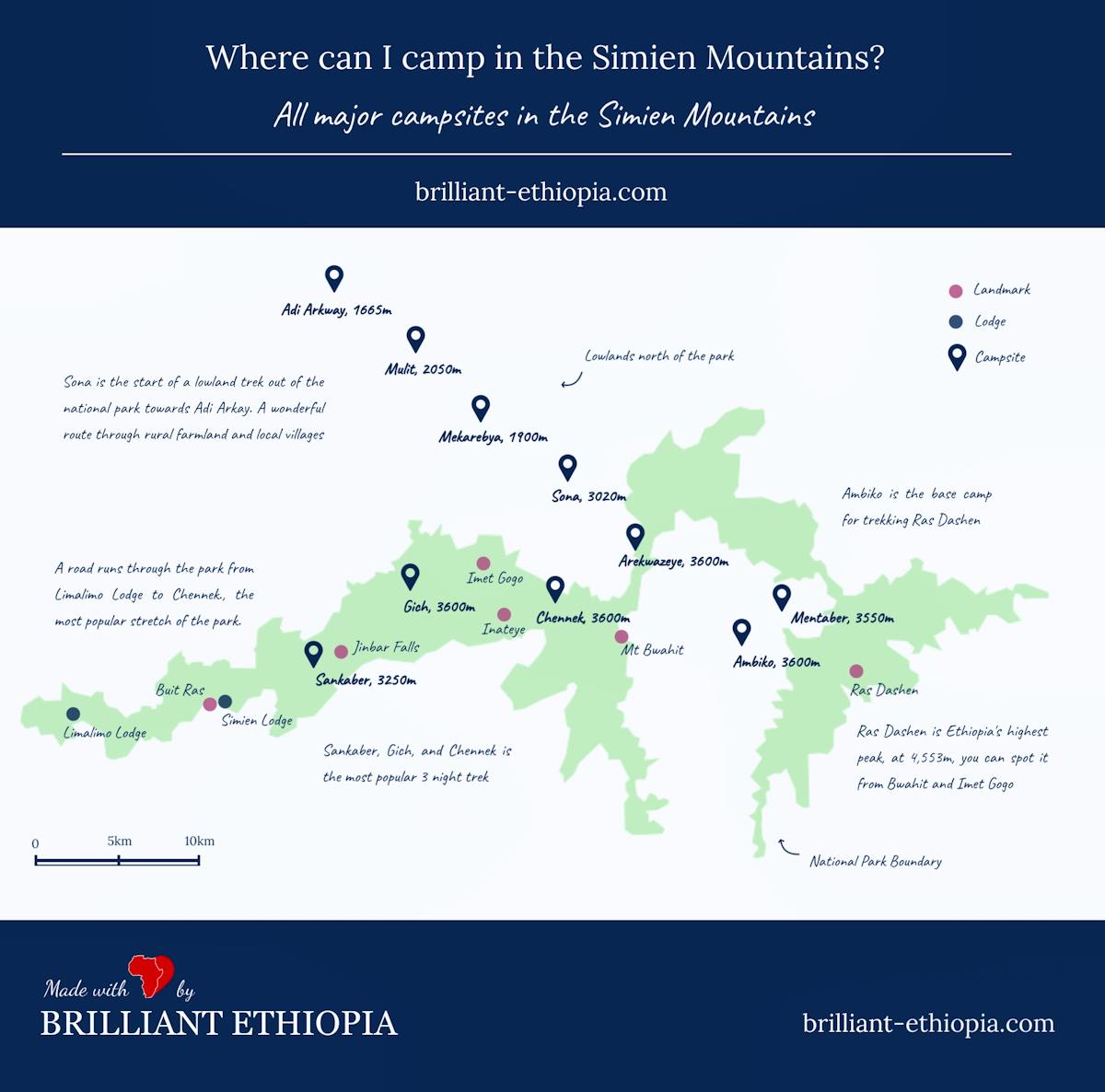
Should I stay in lodges, campsites or community guesthouses?
With two lodges and nine campsites across the park, as well as three community guesthouses just south of the park, there are many ways to experience trekking in the Simien Mountains. Which base is right for you will depend on your fitness levels, interests, budget, and time constraints.
So, what are you looking for?
A day hike or self trek
If you are limited on time but want to get an impression of the Simiens, it is possible to head into the mountains for the day, departing from Gondar in the morning and returning in the afternoon. While you will see some of the best viewpoints thanks to a road that runs through the main trail, you need to be prepared for a busy day. In total, it is a ~6 hour round trip from Gondar to the Simien Mountains (once you have factored in the mandatory stop at Debark to pay your entrance fee and arrange your guide and scout). In total, you will have about 4-5 hours in the park.
If you have a little more time to spare, it is well worth heading first to Limalimo Lodge or Simien Lodge and spending the afternoon enjoying the self-treks around the lodges. The following day, you can spend a full day in the park before returning to Gondar. This spreads the journey to and from Gondar over two days, giving you more time to enjoy the park.
A 2-3 night stay in the outdoors
If you like being in elements and have 2-3 nights to play with, the classic 3-night trek from Sankaber to Chennek is a fantastic option. 2-3 nights gives you plenty of time to hit the major viewpoints and landmarks, and there are a number of trekking routes you can choose from depending on your level of fitness and how much you want to push yourself.
2-3 night stay in comfort
If you want to experience the majesty of the Simien Mountains without compromising on comfort, your best option is to base yourself at either Simien Lodge or Limalimo Lodge and take sorties into the park from there. The Simien Lodge sits deeper into the park itself, which makes it slightly better for self-trekking around the lodge. However, Limalimo Lodge is fast becoming the default base for those who want lodge-stays in the Simiens, simply because of its attention to detail, service, and luxury aesthetics.
From both Simien Lodge and Limalimo Lodge, you can get as far into the park as Chennek via a road running through the primary escarpment. It takes about 2 hours to get from Limalimo to Chennek by car, and the road is very bumpy.
A mix of adventure and R&R
One of the best ways to explore the Simien Mountains is via a mix of camping and lodge-stays. For a typical 3 night trek, you can spend the first 2 nights camping at any two of Sankaber, Gich, and Chennek, before spending the last night relaxing at the luxurious Limalimo Lodge . The number of days you spend camping versus at lodges can be flexed depending on how long you have available (we recommend having at least 2 nights at Limalimo).
To challenge myself
The Simien Mountains have some of the best trekking routes anywhere in Africa. With nine campsites spread across the entirety of the park, it is possible to spend up to two weeks trekking the mountains. Access to some of the best and most challenging treks require overnights camping. In particular, Ras Dashen and Mount Bwahit are best hiked from their base camps.
Consider climbing the big three : Ras Dashen (4,553m), Kidus Yared (4,453m), and Bwahit (4,430m).
With our fantastic partners, we can even arrange treks from the lowlands from Lalibela up into the Simiens with overnights at community guesthouses, and then on into the core of the park.
After any of these adventures, a closing night or two at Limalimo Lodge is a great way to reward yourself.
There are many ways to see the Simiens and we can also help arrange cycling trips, or longer stays for those looking for more adventure.
Trekking in the Simien Mountains is not limited to those willing to camp . There are two lodge options: Limalimo Lodge and Simien Lodge which can make for a much more comfortable stay - it gets cold at altitude in the park, particularly at night when temperatures often drop below freezing which can make even the hardiest of campers pause.
Both Limalimo and Simien Lodge are high-demand, low-capacity lodges -so its worth booking well in advance to secure rooms.
Limalimo Lodge charges more for their rooms, but all meals are included. Simien Lodge charges for theirs, so the costs of the two lodges are comparable. Of the two, we’d recommend trying Limalimo first as it’s the newer and more luxurious of the two.

Sunrise in the Simiens from Limalimo Lodge.
Limalimo Lodge
Limalimo Lodge is fast becoming the default way to explore the mountains, or as a comfortable stop off at the beginning or end (or both) of a camping trip. It’s a beautiful eco-lodge built on the edge of the western escarpment just inside the park with exceptional views. Your room fee includes meals (some of the best served food in northern Ethiopia), and drink (we recommend the local Rift Valley wines!).
A community-led lodge with just 14 rooms all built with local materials and excellent service - Limalimo is often booked up well in advance.
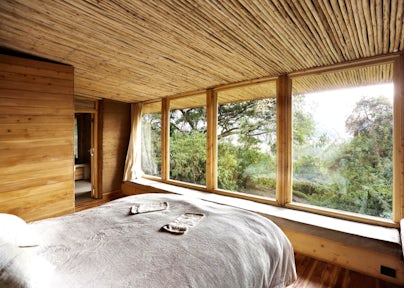
Cosy, cabin-esque rooms at Limalimo Lodge
Simien Lodge
Simien Lodge is the original lodge in the park - famous for being the highest lodge in Africa at 3260 metres, it sits inside the park and is a great base for treks along the primary escarpment towards Chennek, and for self-treks around the lodge.
It is also a great place to wander around and see some of the biggest troops of Gelada baboons playing on the ground and the surrounding fields - they are quite habituated to tourists in this area so you can get up close to them.
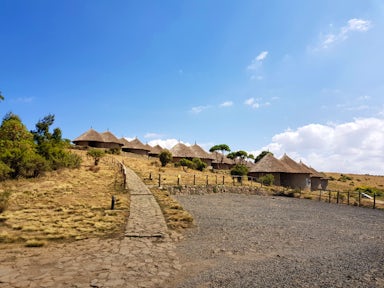
Accommodation in Debark
During peak season, it is not uncommon for both Limalimo Lodge and Simien Lodge to be fully booked. If you don’t want to camp, you can stay overnight at a hotel in Debark, the entrance town to the Simien Mountains. Debark is a small town and the accommodation options are limited and not very good quality.
The best options are the Ras Dejen Hotel or Jeramba Hotel . Staying in Debark is the cheapest way to explore the Simien Mountains, but it is a 1-hour drive into the park from Debark (and a further 2 hours if you want to go as far as Chennek).
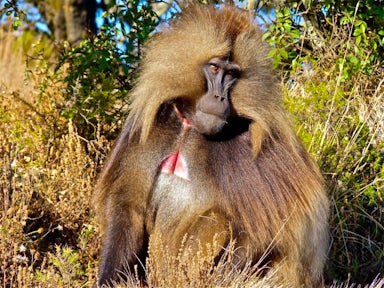
Campsite and lodge opening times in the Simien Mountains
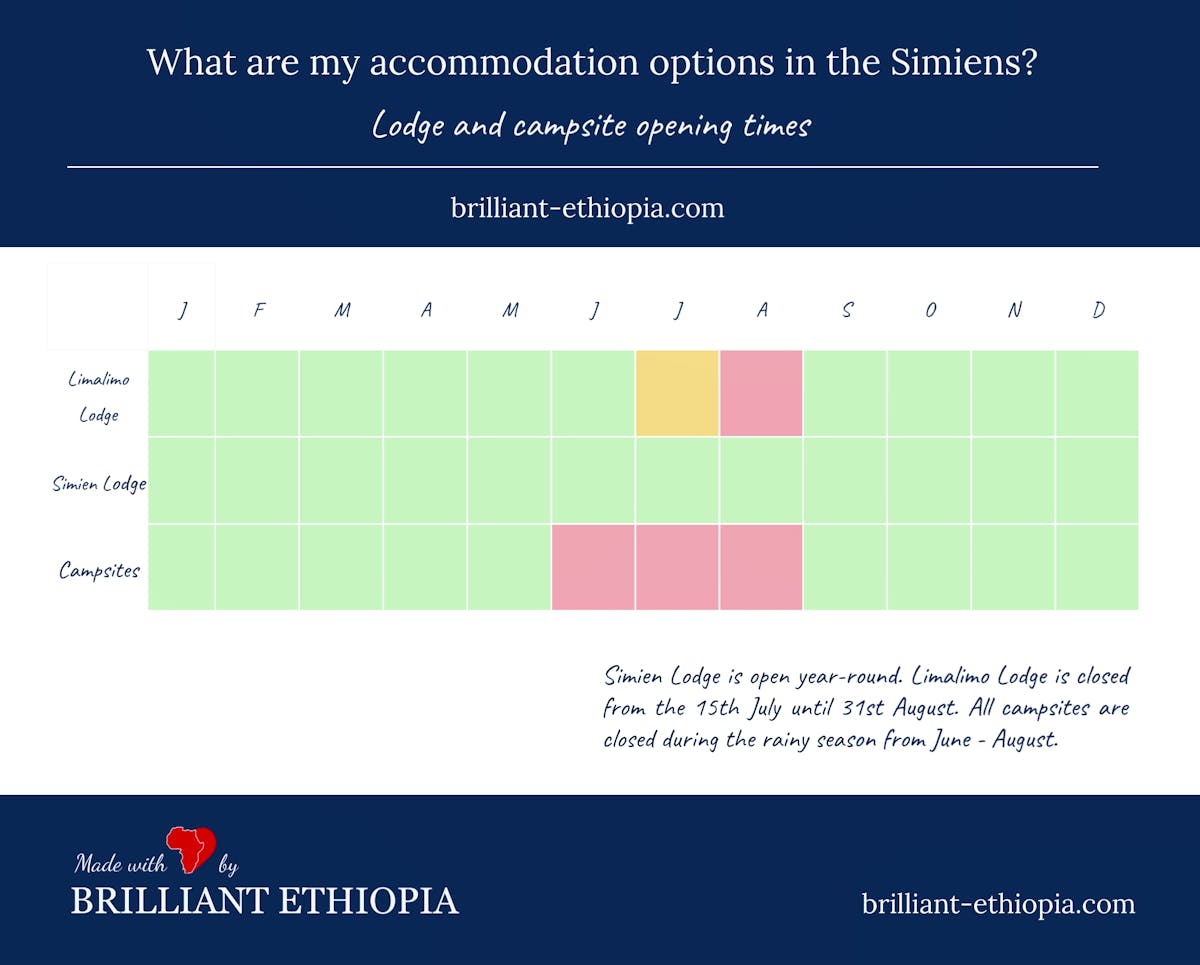
The Simien Mountains National Park are in the Amhara region of northern Ethiopia. The nearest airport town is Gondar, so most visitors will reach the Simien Mountains via a domestic flight into Gondar, followed by a 2-hour drive to the Simien Mountains. Ethiopian Airlines' domestic flight network makes it easy to get to the Simien Mountains from most parts of the country.
How do I get to the Simien Mountains?
From addis ababa.
Ethiopian Airlines run a reliable and comprehensive domestic flight network , with routes to all the major towns in the north and south of the country. The easiest way to get from Addis Ababa to the Simien Mountains is via a short domestic flight to Gondar , the nearest major town to the Simien Mountains. From Gondar airport, it is 103km (a ~2 hour drive) to Debark, the entrance town to the Simien Mountains National Park and the park HQ.
You will be required to stop at Debark to collect the necessary documentation and pick up your guide and scout. From here, a further 1-hour drive takes you into the park itself.
It is not possible to drive straight from Addis to the Simien Mountains in one day - you would need to stop for an overnight en route. We’d recommend flying, if possible.
From Gondar
Gondar is the gateway town to the Simien Mountains. Gondar is 95km (1.5 hours) from Debark. It is a scenic route along the northern highlands (the Kossoye viewpoint is particularly spectacular on the road to Debark and worth a quick visit). The (former) Falasha village, Woleka, makes for an interesting stop.
From Bahir Dar
From Bahir Dar , you can reach the Simien Mountains by air or by road. By road, it is a 3-hour drive to Gondar and then a further ~2 hours to the park (4 hours in total from Bahir Dar to Debark). In most cases, driving is the quickest way to get to the Simien Mountains from Bahir Dar.
There is no direct flight from Bahir Dar to Gondar, so if you travel by air you will need to connect through Lalibela . It is a 30-minute flight from Bahir Dar to Lalibela, and another 30 minutes from Lalibela to Gondar. From Gondar, it is a ~2-hour drive to the Simien Mountains.
From Lalibela
Ethiopian Airlines operate a direct flight from Lalibela to Gondar . It is then a 2-hour drive into the park from Gondar. While it is possible to drive from Lalibela to the Simiens, it is a long ~9 hour drive.
From Mekele
There is no direct flight from Mekele to Gondar, so if you travel by air you will need to connect through Lalibela . It is a 30-minute flight from Mekele to Lalibela, and another 30 minutes from Lalibela to Gondar. From here, it is a ~2 hour drive into the park.
While it is possible to drive from Mekele to the Simiens, it is a long 9-hour drive.
The best way to get from Axum to the Simien Mountains is by road. It is 250km - a scenic 5-8 hours from Axum. The journey is slow going up into the switchbacks of the Simiens mostly on un-asphalted roads but the views are good. It is possible to access the Simiens by air, but the net journey is longer than driving directly.
From Harar , it is a ~75 minute drive to the airport town of Dire Dawa . From here, you can catch a domestic flight to Addis (55 minutes) and connect with a flight to Gondar (65 minutes) to begin the ~2 hour drive to the Simien Mountains.
In most cases, it wouldn’t make sense to put the Simiens right before or after a visit to Harar. You might want to break up the trip with visits to other destinations.
From the Omo Valley
If you’re coming up from the Omo Valley , the quickest route back into the north of the country is via a domestic flight via Addis. The best options are a flight from Jinka to Addis (55 minutes) or from Arba Minch to Addis (65 minutes). From Addis, you will connect with a domestic flight to Gondar, followed by a ~2 hour drive into the mountains.
Another option is to drive from the Omo Valley up through the Rift Valley, breaking up the journey with overnights along the great lakes of Ethiopia before arriving in Addis and flying up to Gondar.
From the Bale Mountains
If you’re coming from the Bale Mountains , you will need to connect to Gondar via Addis Ababa. You can reach Addis with a 50-minute flight from the nearby Robe airport. Alternatively, you can head to Addis via a drive along the Great Rift Valley, spending a night or two by the great lakes to break up the journey.
From Addis, it is a 65-minute flight to Gondar followed by a ~2 hour drive from Gondar to the Simien Mountains.

Brilliant says
The best itineraries sequence destinations to maximise enjoyment and minimise frustration. If the scenery is exceptional, a long road trip can be a better option than a short domestic flight. Finding the balance between experience and logistics requires some thought, and we’re always happy to help.
Highlights of the North and South
The classic northern trail extends south into the Omo Valley, passing through the Rift Valley Lakes and highland peaks of the Bale Mountains. A once in a lifetime adventure combining the very best that Ethiopia has to offer.…
Ready to plan your Ethiopia adventure?
We'll spend some time listening to your aspirations, then discuss the kind of experience that might suit you.
Next we'll discuss the options, shortlist the best trips for you and present you our impartial recommendations.
We'll place a 24 hour hold on your preferred option - without obligation - whilst we talk through the details.
Whatever your budget, group size, length of stay, preferred activity or appetite for adventure, we can help.
This website uses cookies to ensure you get the best experience on our website. Privacy policy
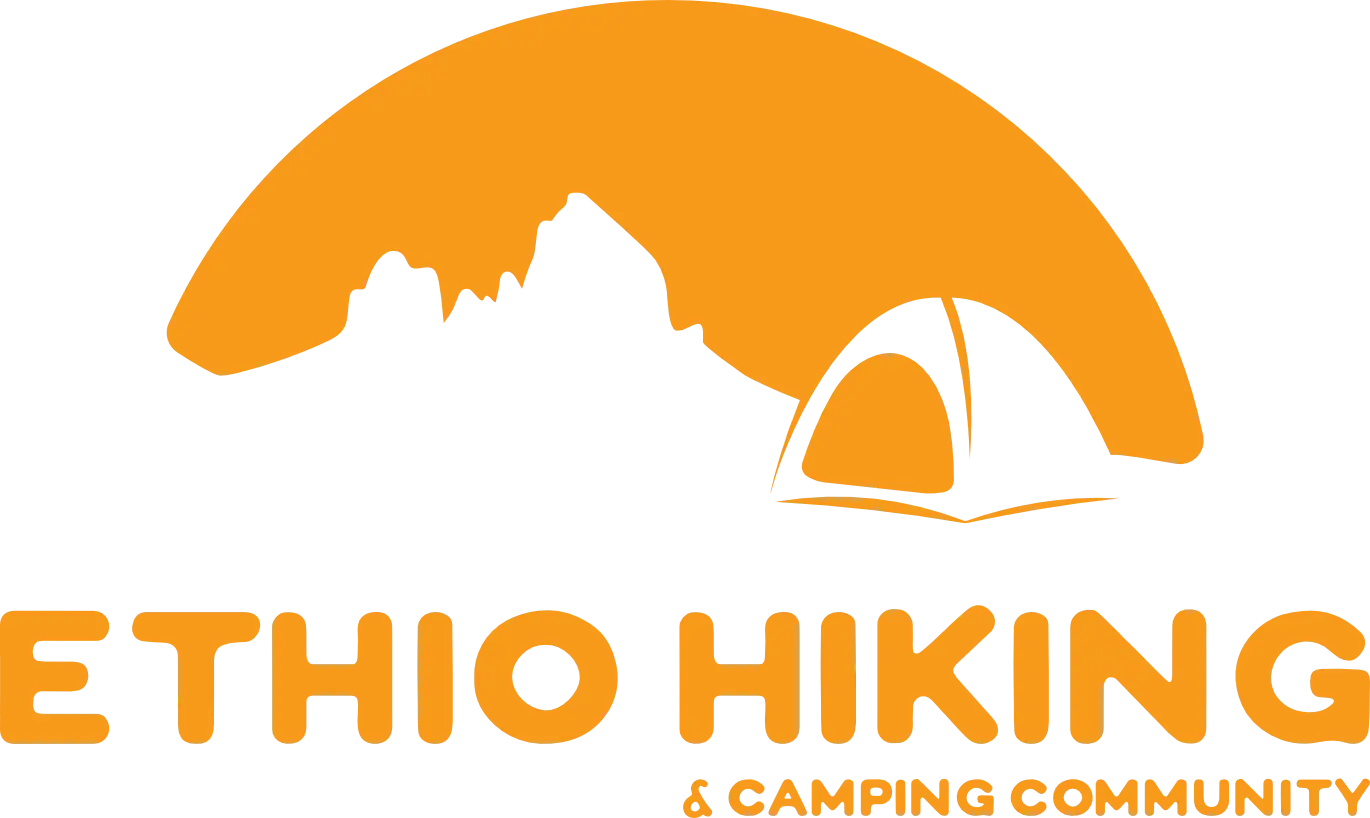
- Destination

Welcome to Ethio Hiking, your gateway to unforgettable adventures in the heart of Ethiopia.
Our Contact
Office phone number, +251 913 857 494, email address, [email protected], follow our social media, travel with us, embrace adventure with ethio hiking.
Our expert guides at Ethio Hiking are passionate about ensuring the safety, enjoyment, and enrichment of every hiker, regardless of their experience level.
Hikers gain a deeper understanding of Ethiopia's rich heritage and traditions, enriching experience that goes beyond the physical landscapes.
Simen Mountains
National park, lake langano, around addis ababa, experience the new adventure.
Embark on a journey of discovery as you immerse yourself in uncharted territories, embrace diverse cultures, and partake in exhilarating activities.
Safe Traveling
We are committed to ensuring that every step of your journey is met with the highest standards of safety and security.
Affordable Price
We believe that the joy of exploration should be within reach for everyone, which is why we are dedicated to offering affordable pricing without compromising on the quality of your experience.
Comfort Accommodation
Our dedication to comfort ensures that every night of your journey is a restful and enjoyable experience.
Building Community
Creating a space where like-minded individuals can connect, share experiences, and engage with the brand.
Discover A Mesmerizing Nature Landscape & Stunning Culture
Immerse yourself in the breathtaking beauty of natural landscapes and the rich tapestry of local culture.
Bale Mountains
Review us on
Begin Your New Life Experience With Exploring New Destination
We invite you to embark on a transformative journey of exploration and discovery.
Join Our Ethiopia Travel Trip
an experience that will leave you with cherished memories and a deep appreciation for the beauty of Ethiopia.
Find Out The Best Travel Choice in Ethiopia
We invite you to discover unparalleled travel experiences with Ethio Hiking.
- Accomodation
Enjoy Our Best Quality Tour & Experience
Providing unparalleled excellence in every aspect of your journey
We recommend bringing sturdy hiking boots, weather-appropriate clothing, a backpack with essentials such as water, snacks, a first-aid kit, and any personal medications, a map or GPS device, and a camera to capture the stunning landscapes.
We offer a variety of trails suitable for different experience levels. Our expert guides will assess your abilities and choose the most suitable route for you.
The best time for hiking in Ethiopia is during the dry season, which typically runs from October to February. This period offers pleasant weather and clear views of the landscapes.
We offer customized tours suitable for families with children and elderly participants. Our guides will ensure that the pace and difficulty level of the hike are appropriate for all members of the group.
Your safety is our top priority. Our experienced guides are trained in wilderness first aid, and we have safety protocols in place for all our tours. We also provide necessary safety equipment and ensure that all participants are well-prepared for the hike.
You are welcome to bring your own hiking gear. However, we also provide rental options for those who prefer not to carry their equipment.
Read Our Latest Travel Blog & Tips Here
Hello world, embark on your adventure today.
Book Now and Experience the Wonders of Ethiopia with Ethio Hiking.
- Traditional Singing
- Monasteries – Idyllic and Remote
- Christian Culture and Heritage
- Urban Spaces and Places
- Walks – Hiking – Horseback
- National Parks – Wildlife – Conservation
- Medieval Frescoes
- Botanical-Floral
- Outdoor Adventure
- Waterways – Oceans – Rivers
- Ancient Christianity
- Cathedrals of Tao
- Ethiopia Cultural Tours
- Viticulture-Highlands (West Georgia)
- Viticulture-Highlands (East Georgia)
- Silk Road Artisans of Georgia
- Walking in the Caucasus (West Georgia)
- Walking in the Caucasus (East Georgia)
- Ethiopia Hiking
- Private Tours
- Botany Tours
- Choir Tours in Georgia
- Conferences
- About Our Company
- Tour Leaders
- Social Outreach
- Tamada Club
- Video Gallery
- Photo Gallery
- Accommodation
- Frequently Asked Questions
- Testimonials (all)
- Group Leader Testimonials
- Facebook Reviews
- Tripadvisor Reviews
- Jim W. (Minn., MN)
- Mark B. (Library Congress)
- Margarite L. (Boston, MA)
- Amanda C. (Yale Uni.)
- Tamara J. (Mercy College)
- Olga H. (Princeton Uni.)
- Christine M. (Greystone Academy)
- Anna B. (UC Davis)
- Carrie C. (VA, USA)
- Jan K. (DE, USA)
- Susan S. (NY USA)
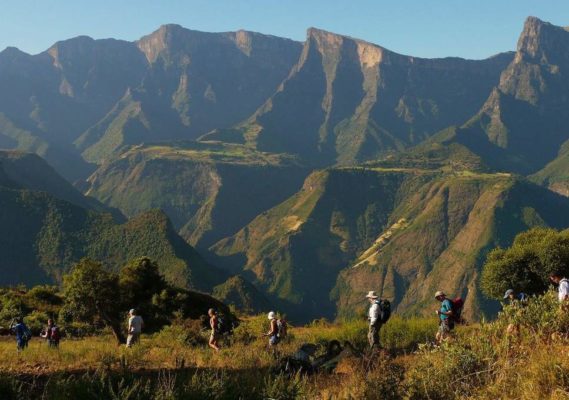
Ethiopia Hiking Tours
Join us for a hiking tour in ethiopia, dates: by private group request (recommend november-december).
Registration: OPEN (Max 16 participants)
(This itinerary is designed for group travel, but may be modified for private groups. Please contact us if you want to arrange for separate dates for your private group)
Arrive-Depart Addis (airport designation ADD).
Travel: This is a 14-day (14 nights inclusive) hiking tour in Ethiopia, focused on the northern highland regions where we will visit national parks and UNESCO heritage sites. Travel is overland, combined with 4 domestic flights.
Visas: obtained online ($52 for US passport holders)
Group Size: maximum 14 guests (only a deposit secures a place in this small-group tour)
Tour Leaders: Christian Sefrin , plus local guides, drivers, scouts, and porters
Contact us for the invitational tour brochure and registration form. Email: [email protected]
Registration:
Submit registration form Send deposit of $1000 to secure your place (details in registration form)
Accommodation will be in the best available hotels and lodges. Ethiopia is not renowned for its accommodation, but we will stay in comfortable 3-star hotels and lodges with ensuite facilities. The locations include Addis, Gondar, Simien national park, Lalibela, Gheralta. Request brochure for details.
Travel will be overland only locally around cities. Otherwise we travel by short domestic flights between regional centers.

See brochure for details including domestic flights, single supplements, and extension tours
Tamada Club :
Gold: 5% discount Silver: 5% discount
Pre-Tour Options
Add a 3-day extension trip to the medieval Islamic city of Harar! Details in the brochure.
Post-Tour Options
Add a 5-day extension trip to the federation of indigenous people's region in southern Ethiopia! Details in the brochure.
Accommodation in high quality best-available boutique hotels specially vetted for comfort and location All ground transportation including airport transfers All meals with wine/beer as noted in itinerary All entrances Guides Entertainment (traditional singers) Water on the bus, snacks (we pamper our guests!)
Not Included:
Airfare Tips for primary guides and driver Personal services (laundry)
Mobility-Fitness:
Standard: 8/10 on the mobility scale (10 being the most demanding).
This tour is organized for people of reasonable fitness level to be able to accomplish all hikes. A typical hike is 3-4 hours round trip (though a couple will be 6 hours round trip), with frequent stops, with support vehicles not far away and easier alternatives for those that do not feel up for the longer walk.
Participants should feel comfortable walking 5-6 miles in a day, and going up/down 1500 feet. The hikes on this itinerary are relatively flat, but altitude will be a factor: we will be above 7,000 feet for the duration of the tour, with most of the hikes happening between 7,500-9,000 feet altitude. Since we are this altitude for the whole trip, it will not feel too extreme as we allow several days after arrival before attempting any serious walking. In the Simien national park, the optional walks are at higher elevations (see brochure for details).
All hikes are described in detail in the brochure.
Special Notes:
Flagship itinerary, most popular destinations This will be dry season, expect lots of sunshine Best available hotels Lots of arts and music on this itinerary Plenty of walks. Optional vigorous walks.
We will expect dry season weather. Lots of sunshine! The mountains will be green after the summer rainy season has drenched the land. In general, prepare for temperatures between 65-85F, dropping to 60F at night. In the Simien National Park, where we spend three nights, the temperatures will be similar during the day time but drop to 40F at night because of the altitude.
Tour Videos (Ethiopia hiking trips)
Travel Program...
Our tour begins and ends in Addis, the thriving cultural and business capital city of Ethiopia. During our brief time in Addis, we will tour two fascinating museums and visit one of the sprawling marketplaces where the commerce of the city is conducted.
After a short flight, we arrive in Gondar, a regional city that was once the heart of a Jewish kingdom. During the 15th-17th centuries, Christian kings overthrew the Jewish kings and built a series of castle complexes that still dominate the downtown area. In Gondar, we will enjoy a performance of Ethiopian traditional dance by one of the University student groups, and partake in a traditional coffee ceremony that involves roasting the beans, heating the coffee in sand, and serving it piping hot in small cups. We’ll also spend a day bird-watching and walking along the shore of nearby Lake Tana, the headwaters of the Blue Nile River (for details on all hikes, see the itinerary in this brochure).
We spend three days in the Simien National Park, which has been called the “Roof of Africa” for its incredible views. The national park is also home to several unique wildlife species including the herbivorous Gelada monkeys, who ‘graze’ in large herds on the high grassland plateau. They don’t mind humans approaching close enough to take good photographs, so one of our hikes will be aimed at locating and approaching these unique, long-haired monkeys. Other species that we may see include the walia ibex, the Ethiopian wolf, and several raptor species. In addition, the park features unique high altitude flora of all varieties which we will learn about on site. The main hike here will be through grasslands and scrub forests down the flank of Ras Dashen, the tallest mountain in Ethiopia, which affords incredible views towards the lowlands to the north.
After a short flight we arrive in Lalibela, a small city in the hills where a medieval king decided to carve a ‘new Jerusalem’ into the surrounding sandstone rock. The product of this industrious and ambitious undertaking is a UNESCO World Heritage Site where 11 churches were carved in two open-air rock-hewn complexes. We will explore these cultural sites, while also doing some hikes in the region over our three-night stay. The main hike in Lalibela will be a ridge walk above the historical town, with fantastic views in all directions.
After flying south the Great African Rift Valley, we will spend three days hiking in the Sidama and Arba Minch area. Here, the lush forests and coffee plantations border on numerous lakes and national parks where wildlife is plentiful and easily observed. We will also organize cultural programs with the Sidama and Dorze local people to learn about their language, culture, religion, and music. A flight back to Addis concludes our tour!
Tour Destinations:
+ Addis, the capital city of Ethiopia, is a 20th century city situated in the center of the country at an altitude of 7,700 feet. In addition to being home to some four million Ethiopians, it is the headquarters for the African National Assembly and many international organizations working in the African continent. Our visit here will focus on two of the more important museums, as well as one of the large marketplaces.
+ Gondar is an ancient city with both a Jewish and Christian heritage. It became an important capital city in the early 1600s, when Christian kings forced out of their northeastern provinces by Ottoman-backed Muslim invaders established their residency in Gondar. To this day, the center of the city is dominated by an impressive array of medieval-looking fortresses.
Simien National Park
+ We will spend three days hiking in the Simien National Park, dubbed the "Roof of Africa" because of its peaks that rise to almost 15,000 feet. Here we will marvel at the spectacular views as the land drops away to the north several thousand feet over the 'escarpment.' On our walk in the region, we will look to find the "red-hearted" Gelada monkeys, ibex, and the Ethiopian wolf which can sometimes be spotted with binoculars.
+ One of the Christian kings declared Lalibela a "new Jerusalem" in the 10th century, and proceeded to sponsor increasingly ambitious construction projects building a series of magnificent churches that are now UNESCO heritage sights. Only, these churches are not built above ground, but dug straight down into the sandstone bedrock. Our visit will coincide with the largest celebration of the year, Nativity ("Genna"), which is celebrated on January 7th. There we will intermingle with thousands of white-clad pilgrims who have traveled from far and wide to witness the important dawn celebration at the iconic Church of St. George. We will explore the UNESCO sites, and spend a full day hiking the high ridge-lines above Lalibela, offering spectacular views in all directions.
+ This region of rolling hills is on the rim of the Great African Rift Valley. The predominant agricultural is coffee cultivation, which means lots of shade forests! There are many lakes and national parks in the region, with abundant wildlife.
+ Further south, we enter the lush sub-tropical region of Arba Minch in order to visit the wildlife refuge at Lake Chamo. We will also spend an afternoon with the Dorze tribe interacting with their local guides, learning about their traditional architecture, cuisine, song, dance, and famous loom textile art.
- Ancient Christianity in the Caucasus May - June Read more Join our feature tour to the most important medieval monasteries and UNESCO heritage sites
- Cathedrals of Tao May - June Join us for an exploration of the forgotten Christian cathedrals in the exotic landscapes of Tao Read more Cathedrals of Tao Cathedrals of Tao Cathedrals of Tao
- Walking in the Caucasus (East) August - September The Tusheti National Park is one of the most inaccessible places in the world, but well worth it! Read more
- Walking in the Caucasus (West) August - September Enjoy summer walks in waist deep wild flowers, snow capped peaks in all directions Read more
- Viticulture & Highlands (West) September - October Explore ancient Colchis, the Black Sea coast, and the mysterious highlands of Svaneti Read more
- Ethiopia: Genna Cultural Tour January Witness one of the great pilgrimages in the world; visit unique UNESCO sites Read more Text layer Text layer
- Go to slide 1
- Go to slide 2
- Go to slide 3
- Go to slide 4
- Go to slide 5
- Go to slide 6
- +251 912 039405
- [email protected]

Extraordinary Ethiopia Tours
For the Real Ethiopian Experience!
TREKKING & HIKING TOURS
3 days bale mountain national park trekking, after breakfast drive from addis ababa to bale mountains national park and arrive at the park headquarters’ in the afternoon hike for an hour possibly spotting two endemic ethiopia mammals that frequently seen to area, 4 days bale mountain national park trekking, today you will have an excursion to sanetti plateau, the highest plateau in africa. here you may encounter the endemics of ethiopia wolf. visit and proceed to harrena forest, the second dense forest in ethiopia., 6 days bale mountain national park trekking, after having your breakfast you will drive southwards to the town of awassa then you will have a fish market tours at lake awassa then take a boat tours to see the hippo later drive to langano. proceed towards the lake langano. the lake is a place to enjoy water activities., 3 days simien mountains national park trekking, trek sankaber – geech (3,600m elevation) which will take between 5-7 hours. after one and half hours, see the jinnbar river and falls which you will cross later in the day. after crossing the river, ascend for about 2 hours to geech., 5 days smnp tours, fly to gondar on ethiopian airlines. meet with vehicles and drive to sankabar the gateway to the simien mountains national park, a unesco world heritage site. meet with guides and prepare for trek., 4 days lalibela trekking tours, breakfast at mekuat community guest house hiking for three hours to meskel. at meskel you will see different type of birds and one of the ethiopian endemic mammals called gelada baboon. lunch at meskel and trek 2:30 hours to wajela., 6 days lalibela trekking tours, breakfast at mekuat community guest house hiking for three hours to meskel. at meskel you will see different type of birds and one of the ethiopian endemic mammals called gelada baboon. lunch at meskel and trek 2:30 hours to wajela. dinner at wajela is noted for its beautiful wood of acacia trees, and numerous stands of eucalyptus in the surrounding village. if this day is a saturday or a tuesday, we would visit the market at dimeke, which is one of the most colorful and interesting in the area (market days in turmi are on mondays). during our time in turmi, we will check whether there is a bull jumping ceremony in the vicinity. this is a rite of passage ceremony for young men, marking their transition to adulthood. we will also check for evangadi or hamer dancing ceremonies., get in touch.
- Cameroon Street Bole Sub-City Kebele 03 Addis Ababa, Ethiopia.
- www.extraordinaryethiopiatours.com
OUR SERVICES
- Premium Tours
- Hotel Booking
- Photography Tours
- Flight Booking
- Trekking Tours
- Birding Tours
- and Many More!

Ethiopia Treks

LOCAL EXPERT GUIDING, TREKS & HIKING TOURS
Trekking in Ethiopia
Mitiku Dessie has been leading treks and hiking tours in Ethiopia since 2011.
With a detailed knowledge of the land – its peoples, geology, plant life and animal life – he has set up Ethiopia Treks to help people arrange hiking trips across the country, as well as bird watching, horse-riding and cultural tours too.
If you would like to discuss anything – routes, ideas for treks, prices, or – please contact Mitiku here .

Share this:
Add your testimonial to Ethiopia Treks’ tripadvisor page – spread the word!
Tripadvisor
“By park regulations, you must hire an armed scout in Debark and arrange your return car in advance, but you’re much better off hiring a guide also. A good guide helps meeting people and knows where and when you’ll have the best chances of observing wildlife. He’ll be full of nice stories about the mountains. I was there with Mitiku Dessie … a real enthusiast and a cheerful companion, and I’m sure you’ll enjoy the mountains if you go with him.”
Theirry from Switzerland, on TripAdvisor, 2015

- Copy shortlink
- Report this content
- Manage subscriptions

Destinations
Trekking type.

Bale Mountains trek

Simien Mountains Extended

Trekking in the Danakil Depression

Trekking in Bale Mountains National Park

Tribes of Omo Valley
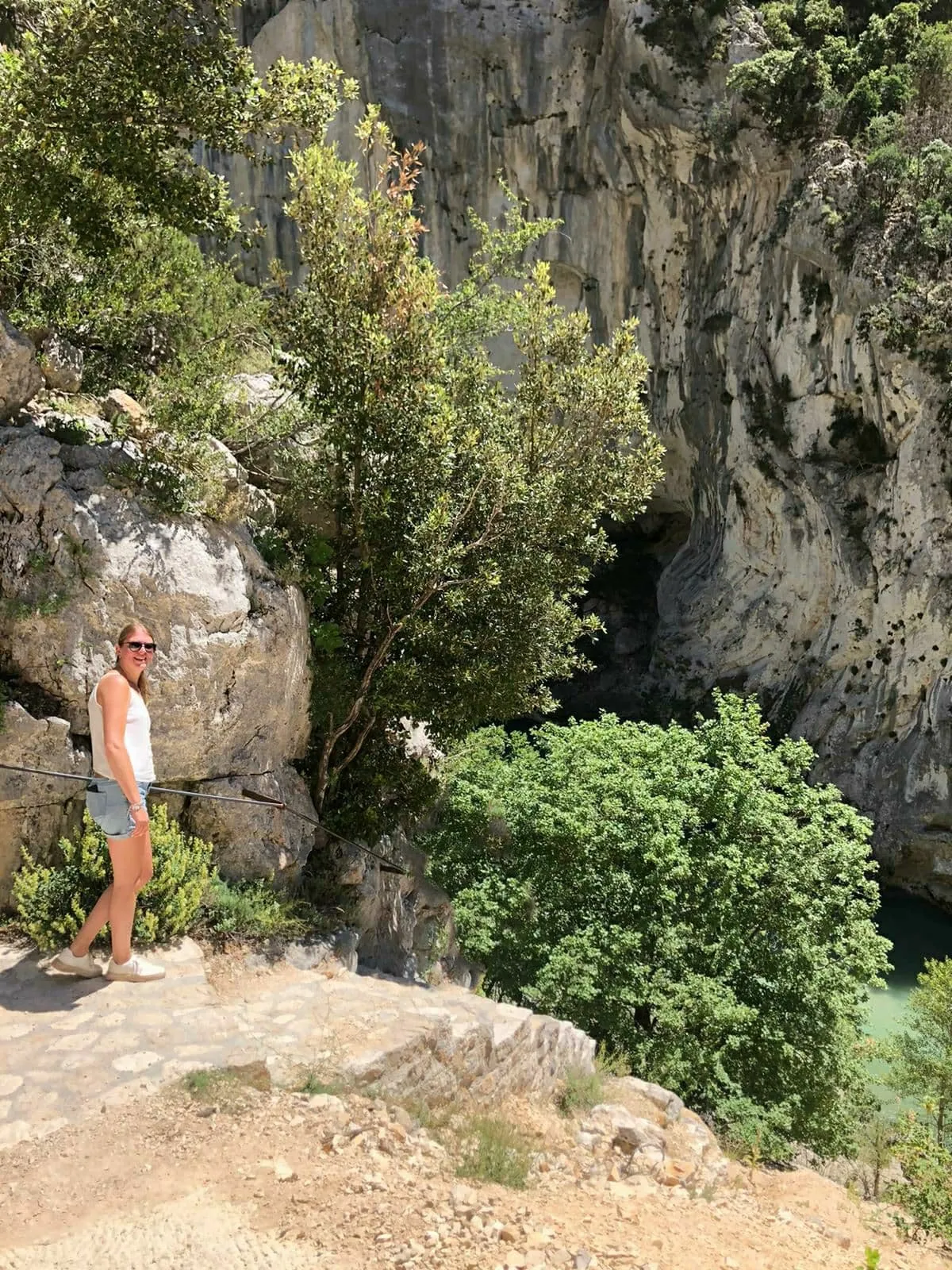
6 days in the Simien Mountains

Trekking in the Simien Mountains

Best of Simien Mountains trek

7-day Simien Mountains trek

5-day Simien Mountaints Trek

Find Ethiopia Hiking & Trekking Trips

A guide to go trekking in the Simien Mountains
By Joan Torres 13 Comments Last updated on April 25, 2024
In memory of Nico Meier, friend and fellow traveler whom I had the great luck to meet in the Simien Mountains, in March 2020. May he rest in peace.

A rugged, mountain range composed of insanely vertiginous cliffs and several peaks above 4000 meters, hiking in the Simien Mountains is, for many travelers, one of the highlights of any trip to Ethiopia .
At 4500 meters above sea level, Ras Dashen is the highest peak, the highest mountain in Ethiopia and the 5th in all Africa and, along with some real jaw-dropping scenery and a large variety of wildlife – especially Gelada monkeys, which you are likely to see in hundreds – it is no wonder that Simien Mountains National Park was declared a UNESCO World Heritage Site in 1979.
This is one of the top trekking destinations in Africa, an adventure you don’t want to miss.
This guide contains everything you need to know to go trekking in the Simien Mountains in Ethiopia, including how to get there, tours, independent travel and trekking routes.
For all the practical tips to visit the country, don’t forget to read everything you need to know to travel to Ethiopia!
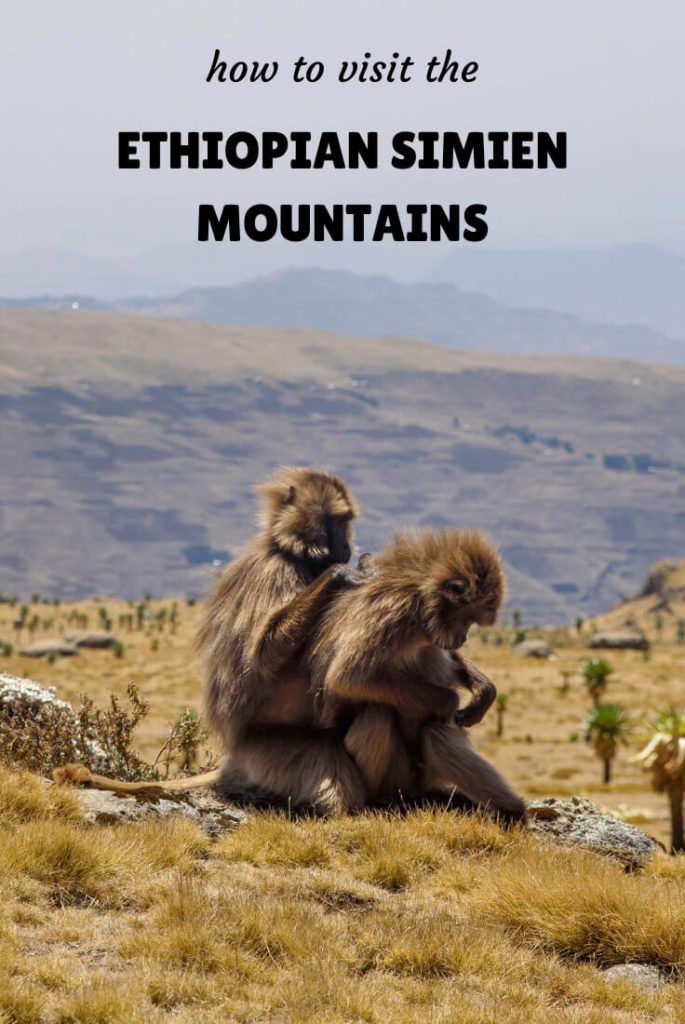
In this guide to trekking in Simien you will find:
Table of Contents
- Best time to visit
- How to get there
- Independently or on a tour?
- Budget and costs
- Where to stay
Simien Mountains wildlife
- Further tips
- More Information
our recommended travel insurance for Ethiopia
With its Backpacker plan, IATI Insurance is the best insurance for any kind of adventurous destination, like Ethiopia.
Introduction to trekking in the Simien Mountains National Park
Hiking the Simien Mountains was one of the best things I did in Ethiopia .
Being one of the very few places in Africa with regular snowfall, the landscape is absolutely breathtaking, plus you get to see plenty of wildlife from very, very close, including hundreds and hundreds of monkeys hanging out together. For me, that was priceless.
I did the Simien Mountains trek during the month of March, which is almost the end of the dry season, when the landscape turns kind of brownish, so I missed all the greenery those mountains are famous for, but that also meant that there weren’t many other hikers around, so we had all campsites pretty much to ourselves.
I decided to do the 3-day trek (most tourists do from 2 to 4 days) but the Simien Mountains offer treks for up to 12 days.
I personally believe that, except for a short climb over a 4000-meter pass on our second day, it was actually very easy, almost like a walk, at least compared to other treks I have done in Georgia and Central Asia .
Let me tell you everything you need to know about it.
Interested in visiting the Omo Valley in Ethiopia? Then, read this post
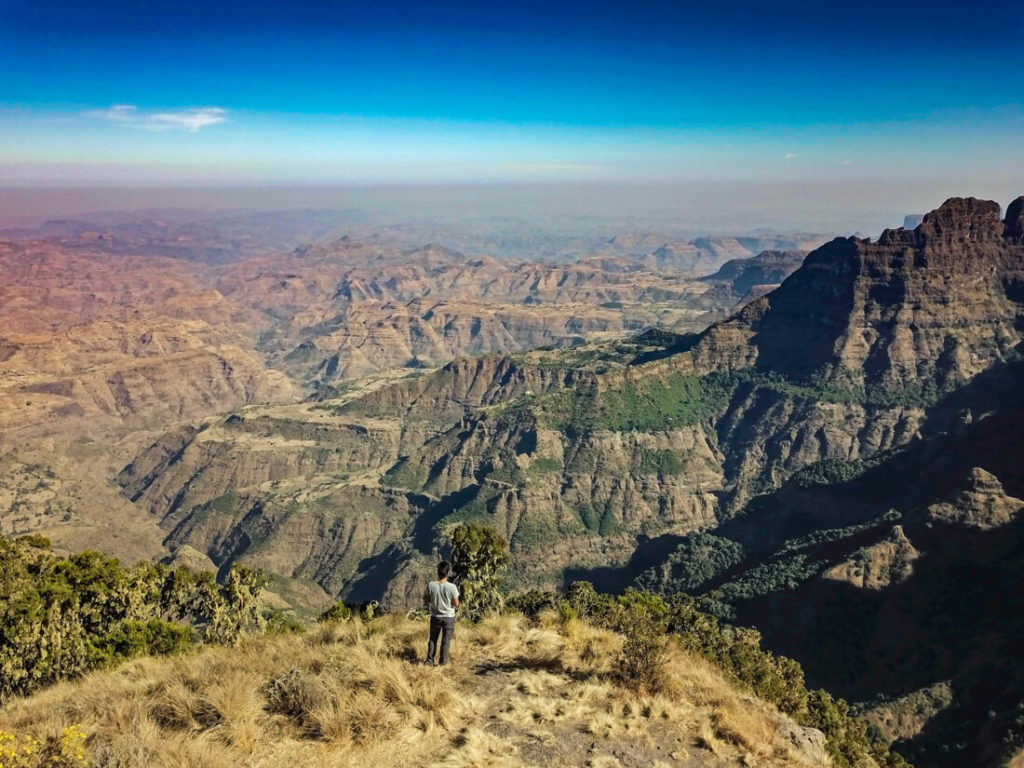
Best time to visit the Simien Mountains
The rainy season runs from May until mid-September, the rainiest months being July and August.
After that, the mountains turn beautifully green and stay like that until December-January so, from a landscape point of view, mid-September to January would be the ideal time hike the Simien Mountains, but bear in mind that it will also be high season and, from what I have heard, the mountains can get pretty packed.
If you can choose, I would try to go in September , when the mountains are at their best and big crowds haven’t come over yet.
February to April is the low season. As I said before, the mountains weren’t at their best, but the drop-dead cliffs were still there and, in 3 days, we just bumped into 3 or 4 other small groups.
You need to assess what works best for you, whether fewer tourists or more greenery, but if I had to go again, I would definitely try to go at the beginning of September.
Many people who travel to Ethiopia are also interested in visiting neighboring Sudan. Read my travel guide to Sudan

How to get to the Simien Mountains
The Simien Mountains is a high plateau located in northeastern Ethiopia, in a region named Amhara , mainly inhabited by the Amhara people, the dominant ethnic group in Ethiopia.
The closest big city is Gonder but the nearest town, from where you actually enter the National Park, is Debark.
If you are coming from the north, Axum is the closest, most famous city. That’s where I came from, but I met an Ethiopian dude who was going there in his car and he charged me the local price.
How to get to Gonder
Gonder is located roughly 650km from Addis Ababa and you can easily take a coach bus from Meskel Square , which typically leaves every day at around 4-5am. Do book your ticket one or two days in advance at least. It’s a 10-hour journey, maybe more.
Alternatively, you can also fly in from Addis or many other cities in Ethiopia.
How to get to Debark from Gonder
Debark is less than a 2-hour drive from Gonder (100km) and local buses run all day.
How to get to Debark from Axum
By the local bus, this will be a very tough, long journey and you may not be able to reach Debark in one day but, to get there, first take a bus from Axum to Shire, and then a second one to Debark.
It’s only 250km but the road is a pretty bad one, so is the local bus.
How to get to the gates of Simien Mountains National Park
The entrance to the gates is located around 15km from the city of Debark . A taxi may cost you around $20, but in Ethiopia, it always depends on how foreign you look.
If you are an adventurous backpacker, know that the national park is home to several mountain villages and I saw many local buses going back and forth. Go to the bus station to ask for timings.
Note – If you book a tour, most tour companies are based in Gonder, so you will need to work out how to get there.

Hiking the Simien Mountains: independently or on a tour?
Important information – As a foreign traveler, you can go trekking in the Simien Mountains independently, and any Ethiopian tour guide telling you otherwise is a big liar.
And I am highlighting this information because all travelers get it wrong.
Before even traveling to Simien, I already knew it from different sources, from a few friends who had done it on their own. Then, in the mountains, we also met one couple doing it by themselves.
The only thing that is mandatory, however, is an armed escort but, by no means are you forced to go with a guide and book a full tour, like not at all.
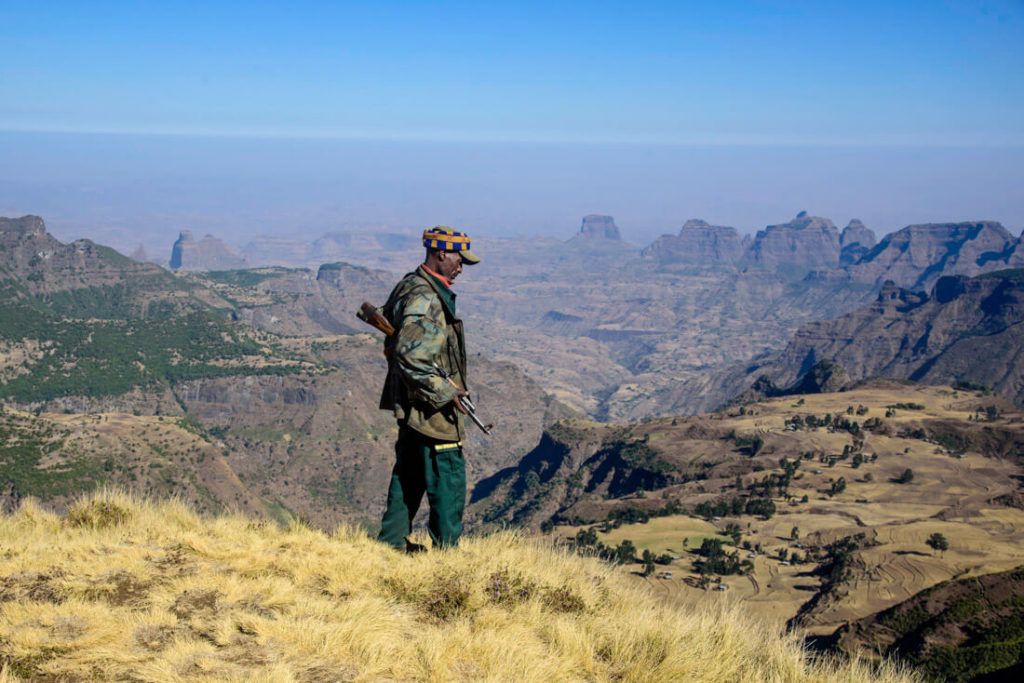
And the reason why most travelers believe this wrong information is because, in the Simien Mountains National Park’s office, the different tour guides will tell you that the law dictates that you must go with a guide (as well as the armed escort) and, if you refuse, they will even pretend to be mad.
The day after I finished my trek, I was having a coffee with another backpacker when one local guide approached us in an attempt to sell us a tour to the Simien Mountains, like the 10th guy in a day.
That backpacker had not done the trek yet, and I jumped in the middle of the conversation saying:
Man, you know you can do it without a guide, right?
The tour guide, nonetheless, denied it and when I told him how I knew it, he became so mad, yelling at me, saying that why do I come to Ethiopia to ruin their jobs, and non-sensical stuff like that, I swear, crazy man.
Anyways, we were discussing doing it independently or not.
Something you need to know, however, is that if you want to go trekking in the Simien Mountains on your own, and you are only one person, the total cost would be practically the same as if you joined a group, as you will still have to pay for:
- Armed escort
- National Park entry fee
- Accommodation (if you don’t have a tent)
- Taxi to the gates and back (you can try the local bus, but the taxi mafia taxi won’t allow you, if they catch you).
If you are two people or more, great but, otherwise, if you do it for the money, there isn’t much difference.
Also, just for you to know, you will find mountain huts along the way where you can stay for very little money and also get a warm Ethiopian meal.
Why I decided to go on a tour
If you are an avid reader of this blog, you will know that I rarely travel on a tour but the Simien Mountains were the last stop of a long African trip throughout Eritrea , Djibouti, Somaliland and Ethiopia, so I was particularly tired, and I just wanted someone to do everything for me, and it turned out to be great.
Whatever you choose, in the Simien Mountains you can’t go wrong.
How to book a tour for the Simien Mountains
The cheapest place to book a tour to the Simien Mountains is by doing it directly in Debark offices. In Gonder, you may be able to find a similar price.
I booked mine, however, through a good local friend (Arre) but had to wait for 1 additional day because there wasn’t a group to join, as it was low season. I highly recommend him, not only because he is a honest local but also because he is a great guy to hang out with.
How to get in touch with my friend Arre:
- WhatsApp: +251961263661
- Phone number: +251919446548
- Website: arretours.com
How much does it cost to go trekking in the Simien Mountains?
How much does a tour to simien cost.
Well, it really depends on many factors (how many people you are, where you depart from, where you book it, etc.) but, for the 3-day trek, expect to pay at least $170, assuming you are a group of 4-6 people and book it in either Gonder or Debark.
That $170 includes permits, guide, armed escorts, food, transportation, etc. I think it’s a pretty good deal.
How much does it cost doing it independently?
Besides food and potential accommodation, you will have to pay for permits and the armed escort, which all together should be around $20 a day.
Then, you will have to pay for taxi to go back to Debark, which costs $100. Alternatively, there is the cheap, local bus but, as I said, if you get caught by the taxi mafia, you won’t be able to get in.
Simien Mountains accommodation. Where to stay
Where to stay in gonder.
Budget hostel – Gondar Backpackers – The hostel where most backpackers stay.
Mid-range hotel – Inn of the Four Sisters – A beautifully decorated hotel right in downtown and, for many, the best hotel they stayed at in Ethiopia.
Top-end – Haile Resort-Gondar – For the most comfort, this is the best hotel in Gonder.
Where to stay in Debark
In Debark, there aren’t good value-for-money options.
Most budget – Atse Tewodros – Quite far from town, but it is the only decent budget option.
Nicer hotel – Tsehay Zeleke Hotel – I stayed here for two nights. It’s a bit pricey for what you get, but, still, it is much better than most options in Debark.
There are some endemic mammals living in Simien, and in our 3 -day trek, we were able to see the following:
Gelada monkeys
Native to this part of the world, the Gelada monkeys are beautiful, hairy monkeys characterized by their heart-shaped red chest patch.
You can get very close to them, but the further you trek, the shyer they get. On our first day, we saw a massive herd composed of several hundred and we were basically sitting and hanging out in the middle of it.
A sort of antelope. We saw a female hidden in the forest.
Ethiopian Wolf
More a chacal than a wolf, but equally beautiful. One of them approached our camp very early in the morning.
The rarest endemic animal in the National Park was close to extinction but it’s been protected and they say their population has increased to 400. We saw one from very far away, climbing a very steep cliff.

Simien Mountains, 3-day trek (route)
I did the 3-day trek in Simien.
The trail is perfectly marked on maps.me
Simien Mountains 3-day trek – Map
Simien Mountains trek (day 1) – Start of the trek to Sankabar
Unexpectedly, we started our trek in the middle of a dusty road but then we realized that it was because the driver saw a herd of monkeys, so the first hour of our trek involved sitting down among a few hundred monkeys while observing them, nothing else.
Weirdly, that was the best part of our whole 3-day trek, but that’s because I like monkeys too much.
When the monkeys went into the forest and the fun was over, we started our way to Sankabar and, for a few hours, we walked over a dizzying, yet absolutely jaw-dropping, cliff from where you get unbelievable views of the Simien Plateau.
Sankabar is a campsite and where you will finish your day.
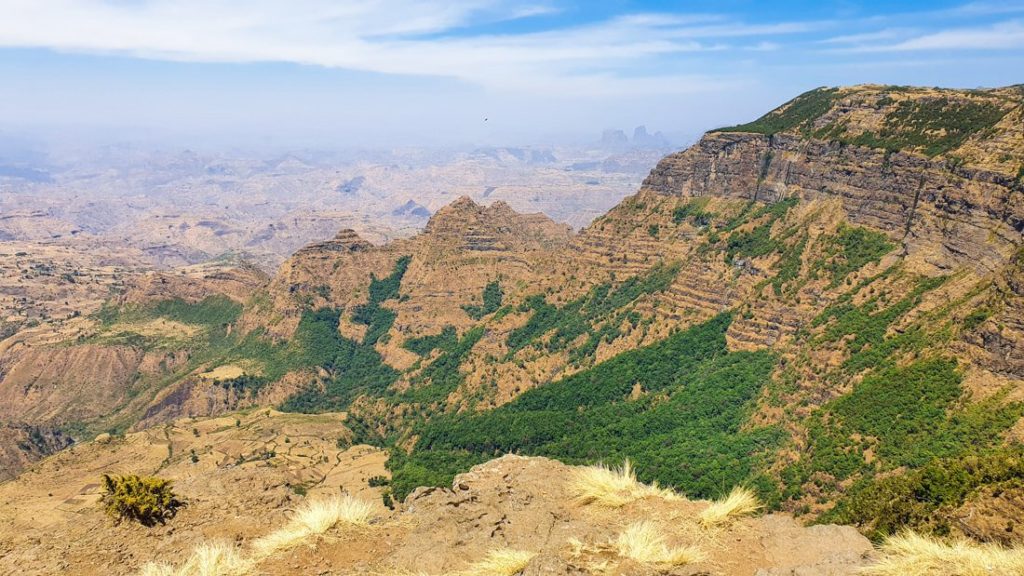
Simien Mountains trek (day 2) – Sankabar to Chennek via Enatye Pass (4070m)
From a landscape point of view, this was the best day of the 3-day trek.
In the morning, we followed the same path that goes over the cliff until we reached Jin Bahir Falls but, since March is dry season, there wasn’t any water but still, the views were beautiful.
Usually, on the 3-day trek, you spend the night in a campsite named Gich but, for some reason, they wanted us to stay in Chennek, the campsite typically reached on the last night of the 4-day trek.
For that, we actually drove for half an hour, skipping the least beautiful part of the trek (they said), until we joined the hiking trail that ascends to Enatye Pass, a stunning 4070-meter high pass, the highest point we reached during the trek and from where we got the most amazing views.

Enatye pass was full of monkeys as well.
Then, we started descending to Chennek campsite.
In Chennek, you can also enjoy some pretty cool views.
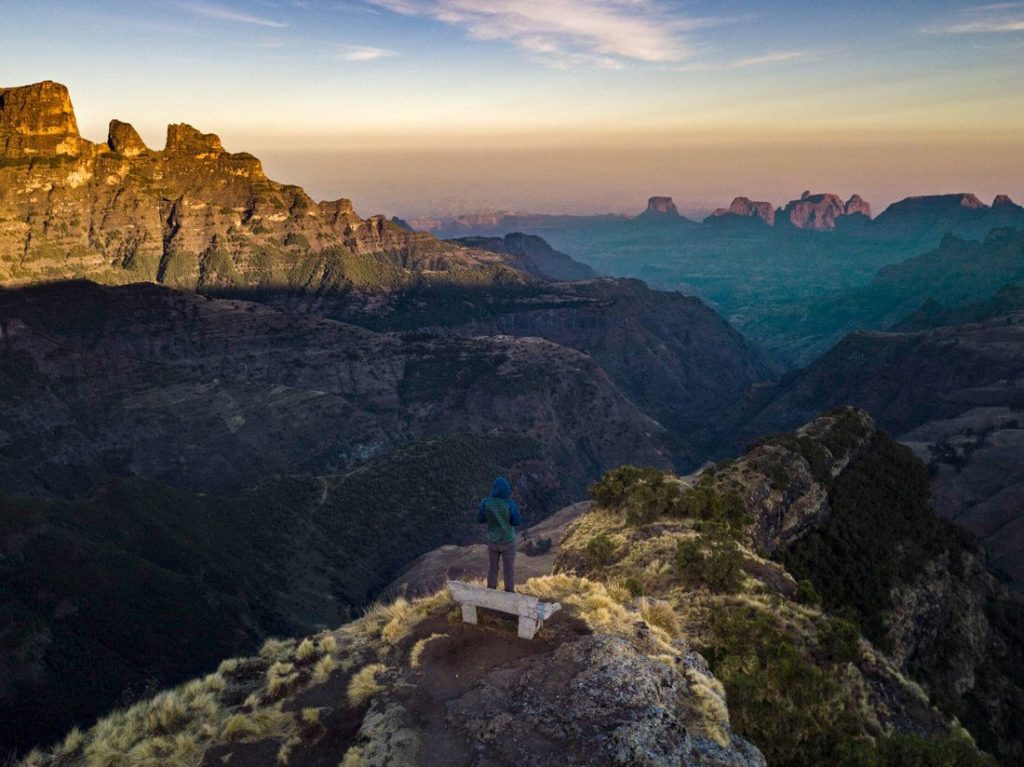

Simien Mountains trek (day 3) – Morning trek and back
In the morning, we just did a few-hours loop around the area, climbing on the top of another great view-point until we got back to Chennek, where we had lunch and the car going to Gonder picked us up.
The journey from Chennek to Gonder takes 5 or 6 hours at least.

Further tips for trekking the Simien Mountains
The food – The food they gave us was all right, just trekking, energetic food like pasta and stuff like that. No Ethiopian food, which was weird.
Beer – You can find beer at 2x the normal price, which is still very cheap.
Armed escorts – They follow you all day but they never say a word, even though ours was smiling all the time.
Sleep – There are mountain huts with bunk beds but, if you go on a tour, they will put you in a tent with a warm sleeping bag.
Bring warm clothes – I don’t know what the weather is like during the rest of the year but, in March, night temperatures dropped below 0ºC. It was by far, the coldest I felt in my whole African trip, which is understandable, given the fact that you sleep at more than 3000m above sea level.
Tips – If you go trekking on a tour, everybody will expect a tip, including cook, guides and armed escorts. Actually, it’s not that they expect it, but they will just tell you directly.
Drones – Be careful if you fly a drone, as it is absolutely forbidden. I did fly mine and one ranger (or guide, not sure) heard it, but we were 5 people and my group didn’t snitch on me, but the guide said that, if caught, the fee is $500 and, if not paid, they would confiscate the drone.
More information for visiting Simien Mountains
📢 In my Travel Resources Page you can find the list of all the sites and services I use to book hotels, tours, travel insurance and more.
Don’t forget to check our travel guide to Ethiopia .
As well as all our Ethiopia articles:
- Omo Valley Travel Guide
- A City Guide to Lalibela
- Danakil Depression Travel Guide

13 comments
Hi, I am wanting to know if you have any advice for bale mountain national park? It seems they only do tour treks? Is this correct? Please can I have some assistance Thanks
Hi Wade, I haven’t been to Bale and unfortunately, I don’t have any info about it
When trekking in the Simien Mountains in Ethiopia, are the required armed guards protecting the trekkers from animals, or, humans ? Please specify what dangers require the armed guards. Thank you.
Hi Tuck, just animals
I noticed you listed the process in dollars and not birr. Is this because you’re expected to pay in dollars?
hi, they quote you in $ for these sort of activities
Thank you Joan for your blog, it has been very useful for my recent trip to Ethiopia (2023, March). Among other things, from it, I started to contact Arre and I want to take advantage of your blog to talk about him. Arre is a person who catches your attention from the moment you start chatting with him, as you soon realise what a good person he is. We have just booked two tours with him: 3 days to visit Danakil (currently done from Semera, being a longer trip than from Mekele). It is an incredible experience, especially to hear and see the Erta Ale volcano roaring and roaring up close. The second tour has been hiking in the Siemens Mountaims, a beautiful place with amazing monkeys (Gelada Monkeys). These are not cheap tours, although Arre provides a competitive price, as you are always accompanied by a driver, cook, guide and military personnel to ensure your safety. In addition, Arre contacts you very frequently to see if you have any problems and to ensure that you enjoy the experience. On top of that, we saw him before we left and he provided us with a very beneficial currency exchange.
Hello I was wondering if its possible to do it with 11 month old baby. How many hours did you hike in total?
Hi Rediet! As a father of a 23-month old, I don’t know if I would… At least the multiple day trek. It was very dry and the sun was really harsh.
Joan, thank you very much for your blog, it’s being very helpful for me.
A couple of updates, Lalibella churches ticket is now 100 $ and Bet Yemherana are 60$ now.
And by the wauy, I contacted Arre since I found his contact in this blog. I have to say, he was very helpfull and friendly, from the first time, always taking care of you, even when you were not with them (with things like providing exchange money for you at a very good rate). Although, I’m not a tours person, at the end I did three tours with them (Danakil/Erta Ale, Simien Mountains and Trigray Churches), and in all of them the quality of the service was excellent. Everything was always perfectly organized and flexible, the food was amazing and in huge amounts, and the crew was very kind! I’ll definitely do the tours again with them.
Muchas gracias Paco!
Thank you for your info. We’re planning a trip to Ethiopia, that includes trekking the Simien Mountains, cometh March 2024.
So your article is indeed a good digital exposure of getting around Ethiopia and in particular, in how to get to the Park.
And the contact person – Arree – we will be getting in touch with him, and you bet, we’ll end up with more than one tour with him as the rest did too.
Thank you, Joan and best travel to you any where else you go!!
Terimakasih; ~ Musafir, The Wandering Moose
thank you, Musafir, have a safe trip!
Leave a Comment Cancel reply
Your email address will not be published. Required fields are marked *
Notify me when new comments are added.

Dates & Prices
Activity level, accommodations, ethiopia simien mountains private hiking tour, trails & traditions in the cradle of humanity, from: $6,395.
- Available: December, March, September, November
- Activity: Level 3
- Accommodations: Comfortable Hotels
- --> --> Group Size: --> -->